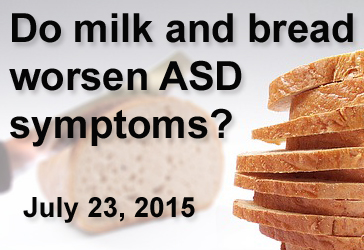Categories
Select a new category
Abilify Effective Against Behavioral Symptoms of ASD
By Chelsea Toledo, M.A. on February 27, 2019
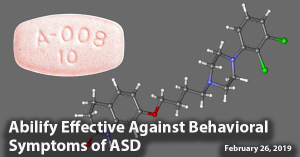
Background: While no standardized treatment exists to treat the symptoms of Autism Spectrum Disorder (ASD), a range of therapeutic strategies may be employed, depending on the specifics of a particular ASD case. Because of the overlap between ASD and certain mental health conditions, some research has focused on the possibility of treating ASD with existing pharmaceutical therapies.
What’s New: A recent review compiled evidence from a series of clinical studies and trials evaluating the safety and efficacy of the drug aripiprazole in treating people with ASD. Aripiprazole, manufactured by Otsuka under the brand name Abilify, is an antipsychotic drug commonly used to treat the symptoms of schizophrenia, bipolar disorder, Tourette’s syndrome, and major depression. In recent years, aripiprazole was approved by the U.S. Food and Drug Administration (FDA) to treat irritability in children and adolescents with ASD.
Combining the results from three studies evaluating results in 408 participants between 1995 and 2017, the researchers found:
- Aripiprazole was safe and well-tolerated among the study participants.
- Aripiprazole was effective in treating behavioral ASD symptoms, including irritability, hyperactivity, noncompliance, and repetitive movements.
- Aripiprazole was not effective in treating lethargy or social withdrawal in participants with ASD.
Why it’s important: This article suggests that aripiprazole may be an effective treatment strategy for some people with behavioral issues related to ASD. Future research on a larger sample of individuals could clarify the best contexts for leveraging aripiprazole.
Help me understand :
| Source(s) : |
| Tweet |
Small Study Shows Promising Results for 3i Play Therapy
By Chelsea Toledo, M.A. on October 2, 2018
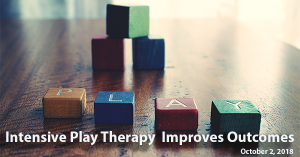
Background: While no standardized treatments exist for individuals diagnosed with autism spectrum disorder (ASD), treatment strategies have been devised which vary based on the type and severity of symptom presentation. Relatively few studies have assessed potential changes in outcomes among children with ASD who undergo play therapy.
What’s New: A recent study evaluated a type of play therapy called 3i, which stands for “interactive, intensive, and individual.” The researchers administered the therapy – which consisted of sensory games (Phase I), symbolic play (Phase II), and interactive play with peers (Phase III) – to 20 French children between the ages of 2 and 14 over the course of 24 months.
The researchers found:
- At the end of 24 months, participants showed significant behavioral and developmental improvement as measured by the Vineland Adaptive Behavior Scales (VABS) and Nidel Imitation Scale;
- Communication also improved among the participants, with the assessed age of communication increasing by 34%;
- Improvements in the VABS socialization score – which increased 83%, on average – occurred more dramatically among participants who had spent the most time doing the 3i regimen.
Why it’s important: This article suggests that 3i play therapy could improve developmental and behavioral outcomes in children with ASD. Future research could demonstrate which children show the most improvement using this technique, informing caregivers’ and clinicians’ decisions around therapy.
Help me understand :
| Source(s) : |
| Tweet |
Vitamin D Improves Autism Symptoms in Clinical Trial
By Chelsea Toledo, M.A. on February 7, 2018
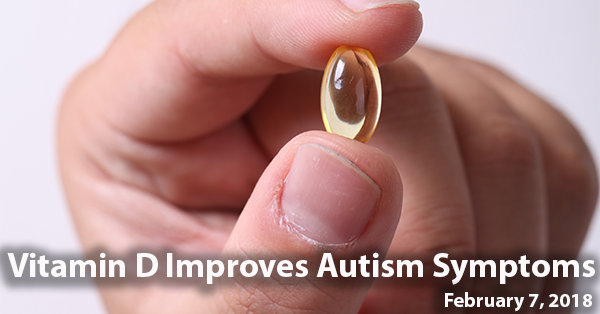
Background: Autism Spectrum Disorder (ASD) is associated of differences in language, behavior and social cognition. For some, these symptoms are quite mild, while others require lifelong care. As such, many families seek therapies to address the difficulties their loved ones face. While no standardized treatments exist for individuals with ASD, several treatment strategies have been developed, specific to the type and severity of symptoms.
What’s New: Several studies have shown that vitamin D deficiency is common in children with ASD. Now, a clinical trial proves that link – and suggests that vitamin D supplementation could improve ASD symptoms. The researchers assigned 109 children with ASD between the ages of 3 and 10 to one of two groups. The treatment group received a vitamin D supplement of up to 5000 IU daily, while the control group received a placebo.
After four months, the researchers found:
- ASD symptoms – as measured by the Child Autism Rating Scale, Aberrant Behavior Checklist, Social Responsiveness Scale, and Autism Treatment Evaluation Checklist – improved in the group that took vitamin D, but not in the control group.
- Blood tests taken before and after the trial showed no major differences in biological markers (such as white blood cell count and glucose levels) between the two groups at either timepoint.
- The children in the treatment arm tolerated a daily dose of 300 IU per kilogram of weight with few side effects.
Why it’s important: This is clinical trial explored the potential of vitamin D3 to aid symptoms in children with ASD. Future studies could refine this treatment strategy and explore the link between ASD and vitamin D deficiency.
Help me understand :
| Source(s) : |
| Tweet |
Cognitive Therapy Boosts Outcomes for Adults with Autism
By Chelsea Toledo, M.A. on January 9, 2018
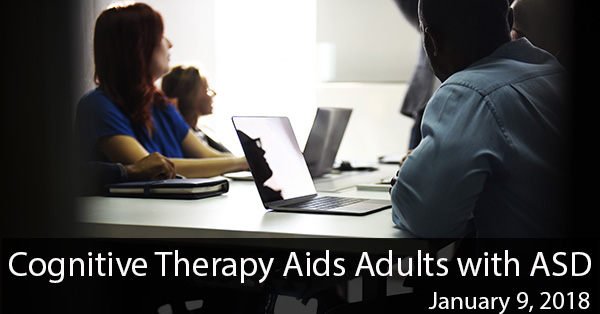
Background: Autism Spectrum Disorder, or ASD, is marked by differences in the processing and communication of both social and non-social information. While a wealth of research has focused on the benefits of early intervention for children with ASD, relatively few studies have explored the effects of therapies on affected adults.
What’s New: A recent study evaluated a technology-based rehabilitation approach known as cognitive enhancement therapy (CET) among adults with ASD. The researchers administered therapy over the course of 18 months to 54 individuals, between the ages of 16 and 44, identified as verbal with ASD. The participants for CET underwent computer-based neurocognitivie training along with group-based training focused on social cognition development. Interestingly, the outcome of CET was compared to that from another therapy, enriched supportive therapy involving improvement of coping skills in individual and group-based sessions.
The researchers found:
Both forms of therapy were linked to improvements in neurocognitive function (measured by MATRICS Consensus Cognitive Battery), with the participants who underwent CET enjoying greater gains after 9 months, but not after 18.
- The greatest improvements among the participants who underwent CET were in attention and processing speed.
- Following the trial, the participants who underwent CET were rated higher than the other participants in managing emotions, emotional intelligence, tolerance, and perception.
- Individuals who received CET were much more likely to secure employment following after 9 months of the trial.
Why it’s important: This study suggests that cognitive enhancement theory could improve outcomes for adults with ASD, meriting further research.
Help me understand :
| Source(s) : |
| Tweet |
Study Explores Brain Activity Related to Joint Attention
By Chelsea E. Toledo, M.A. on November 9, 2017
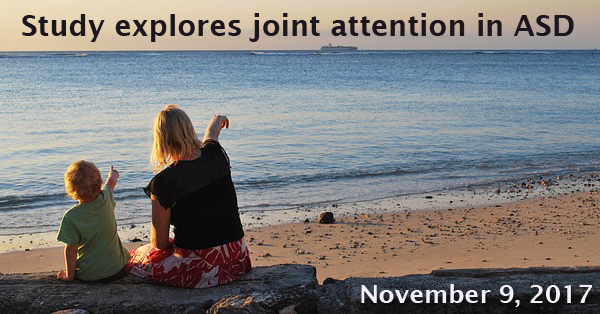
Background: Imagine a man and a woman having a conversation at a coffee shop while waiting for their orders. While they are making eye contact, the woman’s gaze shifts to the counter, where the man’s coffee has now appeared. The man then turns his attention to the drink, as well. This process is called joint attention – the shared focus on an object, cued by a verbal or non-verbal signal from one individual to another. Part of the communicative differences observed in Autism Spectrum Disorder (ASD) arises due to the lack of shared attention.
What’s new: On October 19, 2017, the journal Scientific Reports published a study that assessed the underlying brain activity of eleven 6 to 9 year old boys with high-functioning ASD in situations that called for joint attention. Over a period of six months, the researchers held weekly treatment sessions: the first half of the session was devoted to play-based activity, and the second half to administration of a tablet-based therapy.
To assess joint attention, the researchers recorded the children’s response to one therapist looking at the child and then gesturing to another therapist (responding joint attention), to having a story read by one therapist while another therapist acted the story out (initiating joint attention), and to other scenarios eliciting joint attention. In the second half of the session, they administered a tablet-based therapy game (called GOLIAH, based in the MICHELANGO framework that uses wearable technology to track brainwaves and eye movements).
The researchers collected data on brain activity and eye movements at the beginning and the end of the six-month study. They found that:
- Initiating and responding joint attention have both specialized and overlapping brain activity patterns
- There were changes in brain activity after treatment
- The trends in brain activity following treatment corresponded with modified eye movements
Why it’s important: This pilot study suggests that an approach integrating neuronal and eye-tracking data can provide a clearer picture of the brain’s activity during joint attention. Future studies with a larger sample of participants could shed light on the underlying reasons that joint attention differs in people in ASD – and could lay the groundwork for therapies targeting this skill.
Help me understand :
| Source(s) : |
| Tweet |
Exercise’s Therapeutic Affects Vary in People with ASD
By Chelsea E. Toledo, M.A. on February 15, 2017
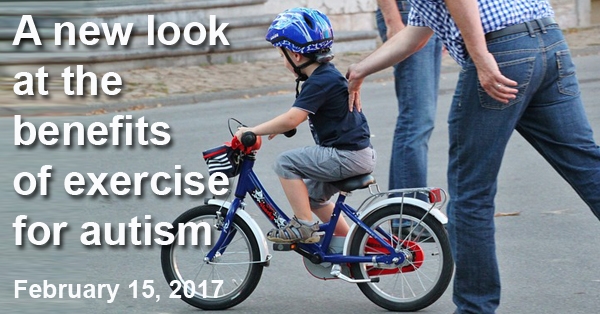
Background: While no “one-size-fits-all” treatment exists for people with autism spectrum disorder (ASD), a variety of therapies are available to ease the social, behavioral and communicative symptoms for those who might need help. Research has shown that exercise can improve cognitive function in people with learning difficulties, but exercise has not been widely studied as a potential therapy for ASD.
What’s New: On July 13, 2016, the Journal of Autism and Developmental Disorders published a meta-analysis – or an umbrella study combining the results from previous research on a single topic – on the cognitive effects of exercise in individuals with ASD. The researchers reviewed data from 22 studies, with a total of 579 participants between the ages of 3 and 29. They found that exercise had a modest effect on cognitive function overall, but that the effect wasn’t consistent for all cognitive symptoms. For instance, the study suggested that exercise could improve individuals’ performance on tasks such as assigning value to coins, but was less effective at improving executive function tasks such as repeating a series of digits that appeared previously on a screen.
Why it’s important: This study supports exercise as an inexpensive intervention for people with ASD to aid in some cognitive functions alongside other therapies. Future studies could pinpoint what types of exercise are most helpful for people on various parts of the spectrum.
Help me understand :
| Source(s) : |
| Tweet |
Therapy Using Parent Training Linked to Improved ASD Symptoms
By Chelsea E. Toledo, M.A. on November 28, 2016
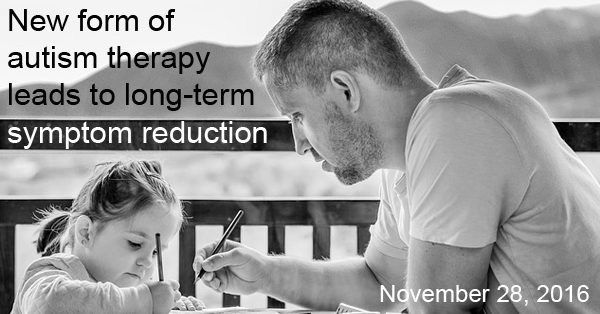
Background: The typical symptoms of autism spectrum disorder (ASD) – which include differences in behavior, communication, and social interaction – usually appear in early childhood. Multiple longitudinal studies have suggested that children who are exposed to early interventions for ASD experience improved outcomes as they develop.
What’s New: On October 25, 2016, The Lancet published a study evaluating the long-term effectiveness of a therapy based on communication training for parents of young children with ASD. This work is a follow up of an earlier study of the Preschool Autism Communication Trial (PACT). Between 2008 and 2009, the researchers administered PACT training to parents of 77 children between the ages of 2 and 4 who had ASD. The recent follow-up study showed that the children whose parents had undergone 12 sessions of the training experienced a greater reduction in scores related to symptom severity than the 75 children whose parents did not undergo the training. The training allowed parents to watch videotaped interactions of themselves with their children alongside a therapist, who provided tailored support.
Why it’s important: This is the first follow-up to a randomized and controlled study that shows an early intervention, in this case PACT, can decrease ASD symptom severity over the long term. Future evaluations could determine whether a parent-centered training like PACT should be considered a standard intervention for children with ASD – and especially for those with severe symptoms.
Help me understand :
| Source(s) : |
| Tweet |
Dosage and DNA Matter for Oxytocin to Work for ASD
By Shana R. Spindler, PhD on September 21, 2016
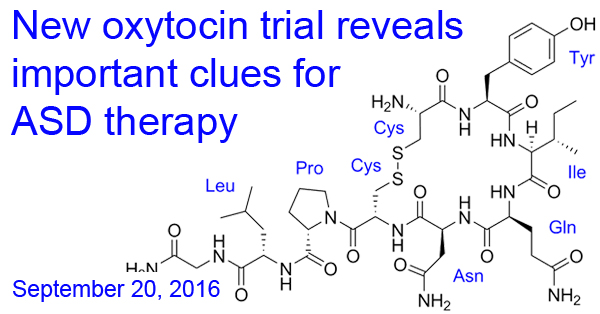
Background: Oxytocin is a small hormone that regulates diverse physiological responses and social behaviors in mammals, including humans. The brain’s neurons recognize the hormone and start a chain of events that lead to emotion recognition and feelings of attachment. This in turn influences social bonding and related behaviors. Because of its powerful effect on the social brain, several studies have tested oxytocin as a treatment for the core symptoms of Autism Spectrum Disorder (ASD), with some success so far.
What’s new: A clinical trial examined two important aspects of oxytocin treatment:
- Dosage levels
- Genetic variations in the oxytocin receptor.
In a randomized clinical trial, researchers gave high- or low-dose oxytocin nose spray, or a placebo, to 20 young adults with ASD per group for 12 weeks. The high-dose oxytocin significantly helped social symptoms in males, but not females. The researchers found that high-dose oxytocin helped males focus on social regions of the face, such as the eyes, and on biological motions. Low-dose helped only those who had a specific DNA variation in the oxytocin receptor gene.
Why it’s important: Researchers can use the results from this clinical trial to help design future trials of oxytocin therapy for ASD. Dosage amounts and a person’s genetic background appear to be important factors to consider during future studies.
Help me understand :
| Source(s) : |
| Tweet |
Diabetes Drug May Balance Weight Gain from ASD Meds
By Chelsea E. Toledo, M.A. on September 6, 2016
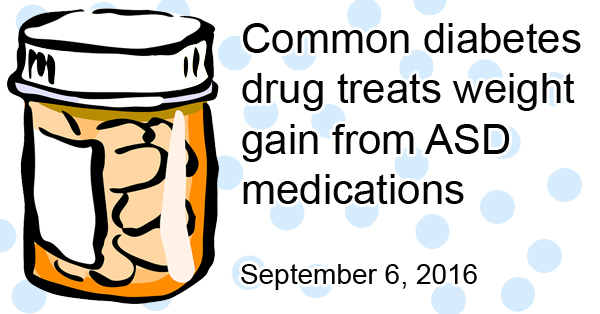
Background: Along with the hallmark symptoms of differences in communication and social behavior, many children with autism spectrum disorder (ASD) suffer from irritability. The U.S. Food and Drug Administration, or FDA, has approved two drugs - risperidone and aripiprasole (types of atypical antipsychotics) - to treat irritability associated with ASD in children. One common side effect of these drugs is significant weight gain.
What’s New: A new clinical trail has examined efficacy of another drug for reducing weight in children diagnosed with ASD and taking atypical antipsychotic drugs for irritability. Over the course of 16 weeks, the researchers conducted a randomized, controlled clinical trial in which they administered either a placebo or metformin - commonly used to treat diabetes - to 60 children between the ages of 6 and 17 with ASD who had experienced weight gain while taking an atypical antipsychotic drug. They found that the group taking metformin experienced significant weight loss, with reductions between 5 and 9 percent of their body mass index.
Why it’s important: This study suggests that the use of metformin could balance out the weight gain experienced by children taking atypical antipsychotics for irritability in ASD - helping them to have healthier outcomes. Future studies could determine whether this treatment is effective at maintaining weight loss, and whether it could prevent weight gain at the start of atypical antipsychotic drug treatment.
This study was published on August 24, 2016, in the scientific journal JAMA Psychiatry.
Help me understand :
| Source(s) : |
| Tweet |
Cognitive Behavioral Therapy at School Eases Anxiety
By Chelsea E. Toledo, M.A. on August 2, 2016
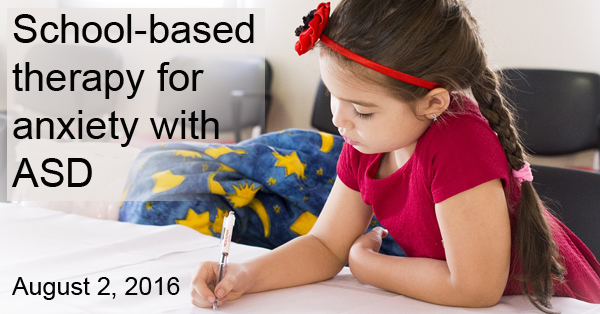
Background: Autism spectrum disorder (ASD) is characterized by differences in communication and social behavior. Other symptoms, including anxiety, frequently accompany ASD. Researchers have estimated that as many as 40 percent of children with ASD had also been diagnosed with an anxiety disorder.[1] How best to treat anxiety with ASD is an area of ongoing research.
What’s New: A new study explores the effectiveness of a school-based cognitive behavioral therapy (CBT) on adolescents with both ASD and anxiety. Researchers assigned 35 children between the ages of 11 and 14 either to a waitlist group (control) or to receive weekly therapy sessions of 90 min each for six weeks. The treatment included Exploring Feelings, a workbook-based program analyzing the range of human emotions through CBT. They found that the 18 participants who received the intervention showed improvement in anxiety symptoms - as reported by parents, teachers and through self-evaluations - as well as marginal improvements in social responsiveness at school.
Why it’s important: This study suggests that CBT delivered at school can be beneficial in easing the anxiety that children with ASD face when attending mainstream schools. This is important because some studies show that less anxiety at school leads to improved outcomes for children with ASD.
[1] Anna Merrill. Anxiety and Autism Spectrum Disorders. Indiana Resource Center for Autism. Accessed July 31, 2016. https://www.iidc.indiana.edu/pages/anxiety-and-autism-spectrum-disorders.
Help me understand :
| Source(s) : |
| Tweet |
Mom’s Obesity May Up ASD Risk Due to Gut Bacteria
By Shana R. Spindler, PhD on June 22, 2016
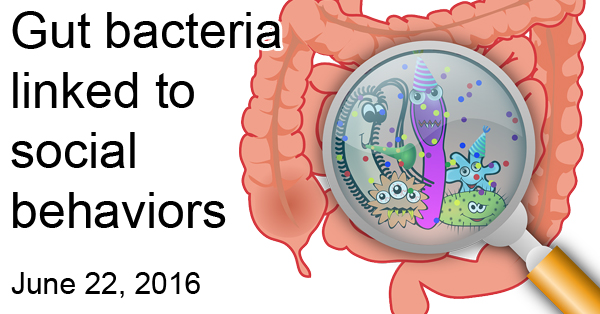
Background: Previous research has found an association between maternal obesity and an increased risk of autism spectrum disorder (ASD). A key question is how a mother’s obesity could affect her child’s risk of the disorder. By using animal models, researchers can study what factors are important for the association between maternal obesity and ASD.
What’s new: On June 16, 2016, the journal Cell published a study examining the link between obesity and autism risk using mice. Researchers put mice on a high-fat diet (or normal diet for controls) and studied the resulting pups’ behaviors. As expected, the pups in the high-fat group lacked several social behaviors typical to mice. The researchers found that a decreased diversity of gut bacteria due to high-fat diet affected the pup’s brain’s response to oxytocin, a chemical involved in social bonding. In a series of experiments, the researchers showed that exposure to gut bacteria from mice on normal diets helped the pups born to obese mice establish normal social behaviors.
Why it’s important: For the first time, researchers showed that increased autism risk from maternal obesity might be due to differences in gut bacteria, at least in mice. This study adds to the growing body of evidence that the health of your gut affects the workings of your brain, and part of a healthy gut includes a diverse community of beneficial bacteria. With additional research, the relative safety and availability of probiotics makes gut health an attractive target for autism therapy, or maybe even prevention.
Help me understand :
| Source(s) : |
| Tweet |
ESDM Most Effective in Young Children, Study Finds
By Chelsea E. Toledo, M.A. on May 25, 2016
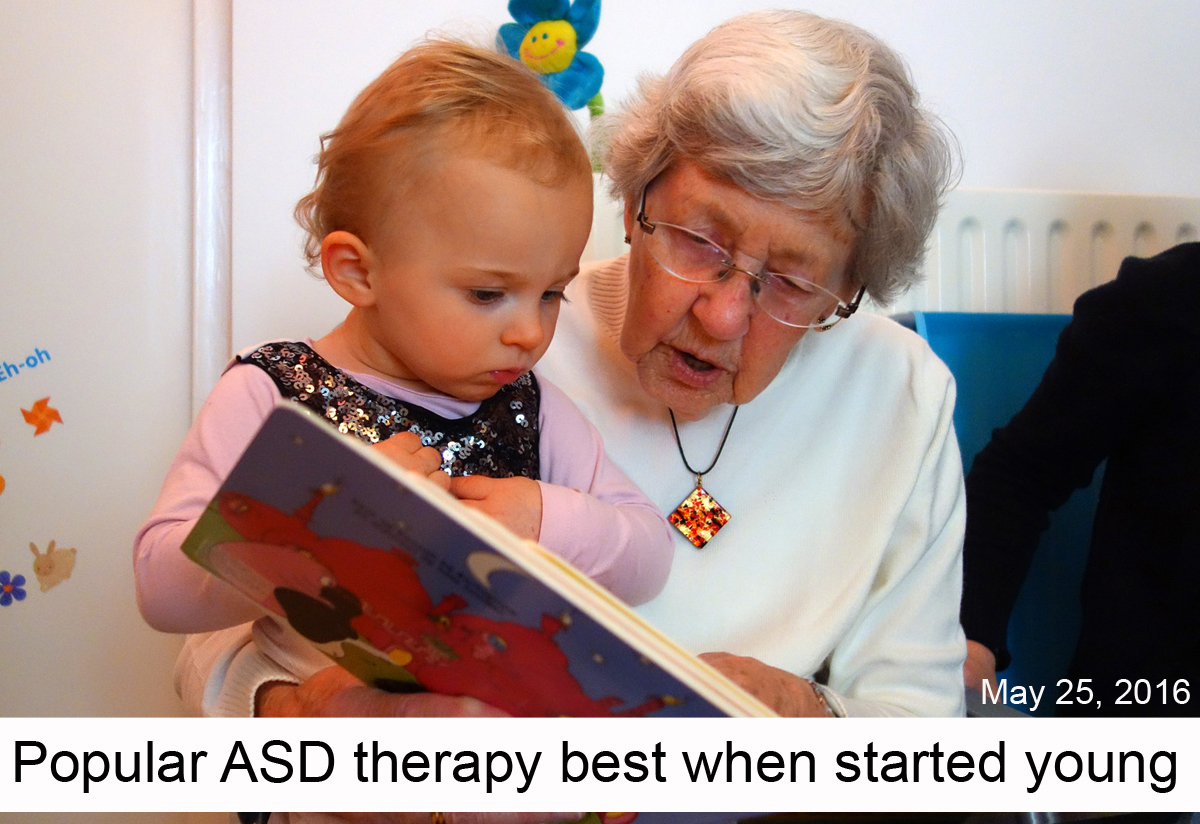
Background: The Early Start Denver Model (ESDM) is an intervention designed for children 12 to 60 months of age with autism spectrum disorder (ASD). A team of trained professionals including therapists, teachers, childcare workers and psychologists deliver this program; parents receive guidance from the therapy team as well. ESDM aims to help children gain social skills and engage in interpersonal relationships. It uses child-directed methods like simultaneous movement, rhythm, and reciprocal behavior.
What’s New: On March 28, 2016, the Journal of Autism and Developmental Disorders published a study exploring the effects of ESDM in children of different ages. The researchers administered diagnostic questionnaires to assess verbal and non-verbal communication, as well as ASD severity, in 32 children between 18 and 48 months of age and in 28 children between 48 and 62 months of age. Prior to the questionnaires, the children participated in ESDM for a year. While all participants improved non-verbal communication, the younger group had significantly greater improvement on the verbal diagnostic questionnaire. None of the children reduced their ASD severity scores.
Why it’s important: This study supports the basic principal underlying ESDM – that early intervention is most effective, especially in achieving gains in verbal communications. Future studies could compare gains with a control group not receiving ESDM therapy to more thoroughly evaluate program effectiveness.
Help me understand :
| Source(s) : |
| Tweet |
Cheaper Behavioral Therapy Studied for Low-Income Countries
By Shana R. Spindler, PhD on May 17, 2016

Background: Children with autism often work with a therapist to improve communication and social skills. Sometimes therapists give parents strategies for interacting with their child. This is the case with the Preschool Autism Communication Trial (PACT).
During PACT therapy, professional speech and language therapists teach parents how to adjust their communication and social interactions to the needs of each child. Previous studies have shown an increased cost of therapy with PACT, but no significant difference in overall outcome to warrant the cost. In 2015, a collaboration of researchers in India, Pakistan, and the United Kingdom modified the PACT therapy for children with autism living in low- to middle-income countries.
What’s new: Researchers tested the modified PACT-based therapy, called PASS (Parent-mediated intervention for Autism Spectrum Disorder in South Asia) in India and Pakistan. The researchers randomly divided 65 children with autism between the ages of 2 and 9 into two groups. One group received 12 sessions of PASS plus treatment as usual, while the other group continued their typical activities during that time.
During PASS sessions, a health worker and parents watched video tapes of the parents and child playing together and discussed strategies to improve the child’s skillsets. The researchers found that PASS improved the coordination and initiation of social interactions between parents and children with autism in a low-income setting.
Why it’s important: The authors report that this is the first rigorous trial to test an autism therapy in a low- to middle-income country. While PASS showed important positive outcomes, it also linked to decreased shared attention between parents and children. This previously unreported effect of a PACT-based therapy adds to conflicting reports of its effectiveness for autism.
Help me understand :
| Source(s) : |
| Tweet |
Cutting-edge Autism Therapy May Lessen Problem Behaviors
By Shana R. Spindler, PhD on May 10, 2016
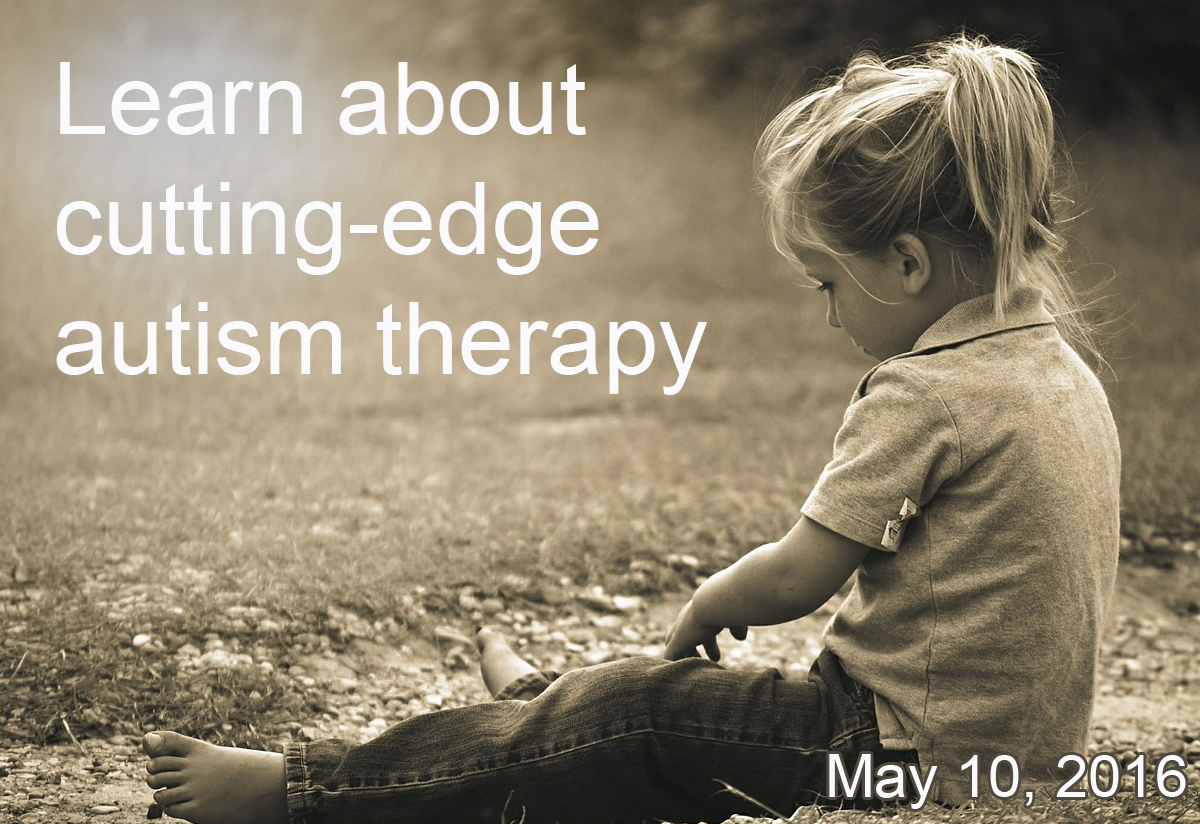
Background: Have you ever wondered what controls your heart rate? The autonomic nervous system controls all non-voluntary movements in your body, like the beating of your heart and contractions of your stomach and intestines. In some individuals with autism, the autonomic nervous system doesn’t work properly. This may lead to a less intense response to social stimuli. Some researchers believe that activating the autonomic nervous system may help individuals with autism respond to social cues in a more typical way.
What’s new: A cutting-edge procedure called transcranial magnetic stimulation (TMS) may help children with autism lessen hyperactivity, inappropriate speech, and repetitive behaviors by adjusting their autonomic nervous system activity, according to a study published March, 2016. The researchers used repetitive magnetic fields to excite neurons in a part of the brain behind the forehead in 33 children with autism. The children each participated in 12 weekly sessions of TMS. During the treatment, the childrens’ autonomic nervous system measurements improved, and following treatment, several behavior scores got better.
Why it’s important: Compared to previous studies of TMS, this study increased the number of children treated and allowed children from all severities of the autism spectrum. The positive results of the study lead the way for researchers to create randomized, controlled clinical trials to test if TMS treatments work better than other therapies.
Help me understand :
| Source(s) : |
| Tweet |
Responsive Play as a Therapy for Autism
By Shana R. Spindler, PhD on April 26, 2016
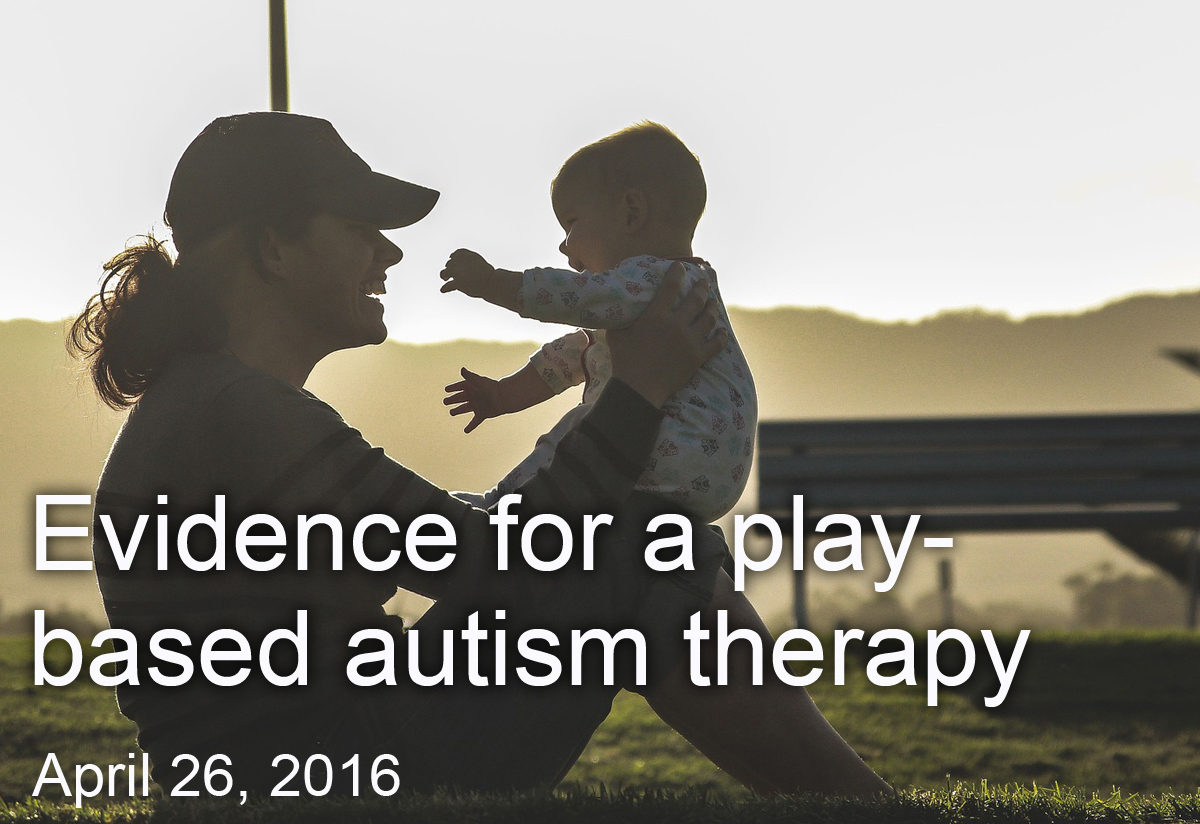
Background: Play is critical for the social and emotional growth of children. In a type of interaction called responsive play, parents follow the lead of the child, reacting to the child’s interests and movements rather than guiding the direction of activity. Several studies have found that responsive play may improve the social engagement between children with autism and their caretakers.
What’s new: In the May 2016 issue of the Journal of Autism and Developmental Disorders, researchers published a study testing the effectiveness of a responsive therapy called JASPER, which stands for Joint Attention, Symbolic Play, Engagement, and Regulation. In the study, 85 children with autism and their parents were randomly assigned to participate in JASPER or a parent-only, discussion based training session. Each program consisted of weekly one-hour training sessions for ten weeks.
At a six month follow-up visit, compared to parents who received parent-only education, the parents from the JASPER group had increased responsive behaviors to their children, and their children spent more time jointly engaged.
Why it’s important: This study links increases in a child’s social engagement to improvements in a parent’s responsive behavior following JASPER therapy. Previous studies of JASPER focused only on the improvements in the child’s engagement.
Help me understand :
| Source(s) : |
| Tweet |
Non-invasive Brain Monitoring, a Potential ASD Therapy
By Chelsea E. Toledo, M.A. on April 19, 2016
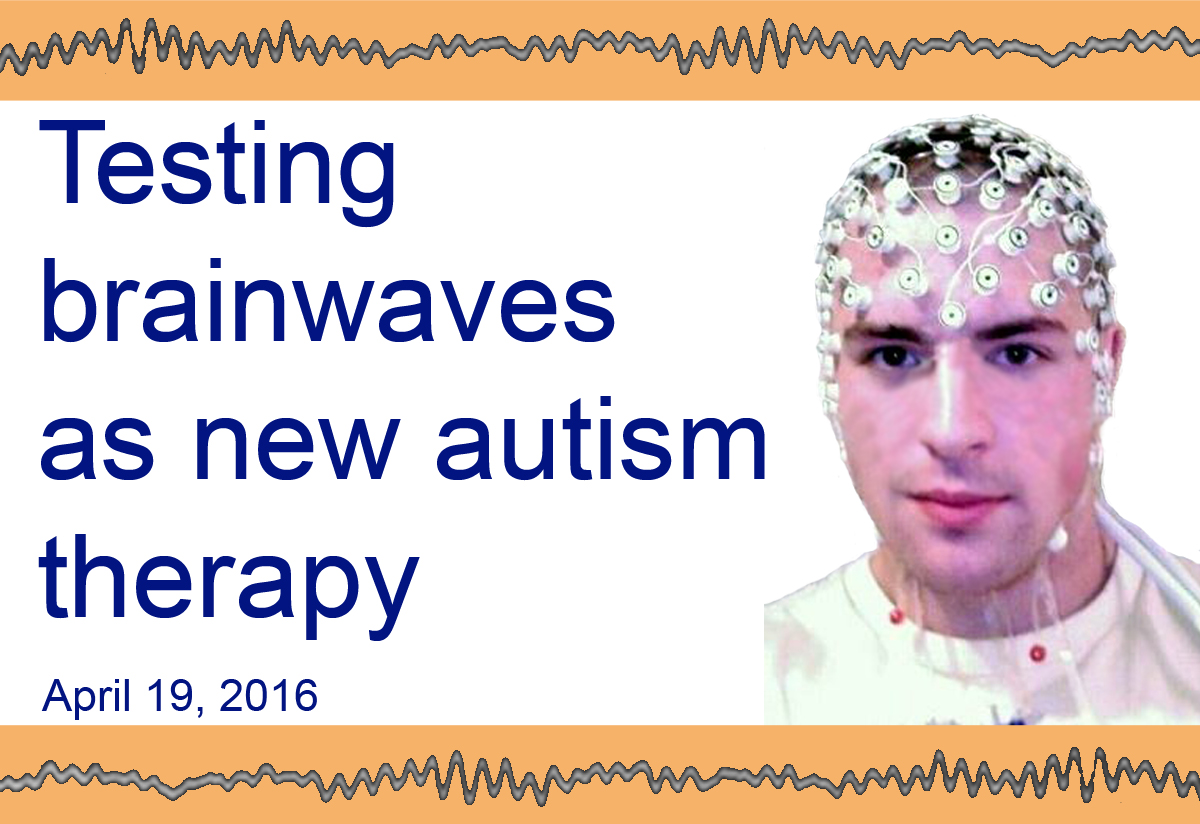
Background: Among the treatments being considered for autism spectrum disorder (ASD), neurofeedback shows an indication of brain activity in real time, which helps people learn to regulate how their brains are functioning. The most common form of neurofeedback is analyzed using electroencephalography (EEG), which involves placement of electrodes on the scalp to measure changes in electrical activity within the brain. This process is frequently used to diagnose epilepsy.
What’s new: On January 14, 2016, the journal, Frontiers in Human Neuroscience published a study exploring EEG’s potential as a treatment for ASD, with a focus on the relationship between different frequency bands generated as a result of recording specific waveform oscillations in the brain’s activity. Researchers used the technology to monitor the brain activity of 18 participants with high-functioning ASD. After 18 weekly EEG sessions, they found a reduction in EEG characteristics associated with ASD in the brain’s prefrontal cortex – specifically those related to focused attention. They also saw improvement in lethargy and social withdrawal, as measured in an established questionnaire that was administered to parents at the beginning and end of the study.
Why it’s important: This study suggests that using neurofeedback from EEG analysis is a potential therapy for high-functioning children with ASD. Future research could hone in on specific techniques that compare relationships between frequency bands for the most effective method of treatment.
Help me understand :
| Source(s) : |
| Tweet |
Robots and Rhythm May Help Motor Difficulties in Autism
By Shana R. Spindler, PhD on April 14, 2016
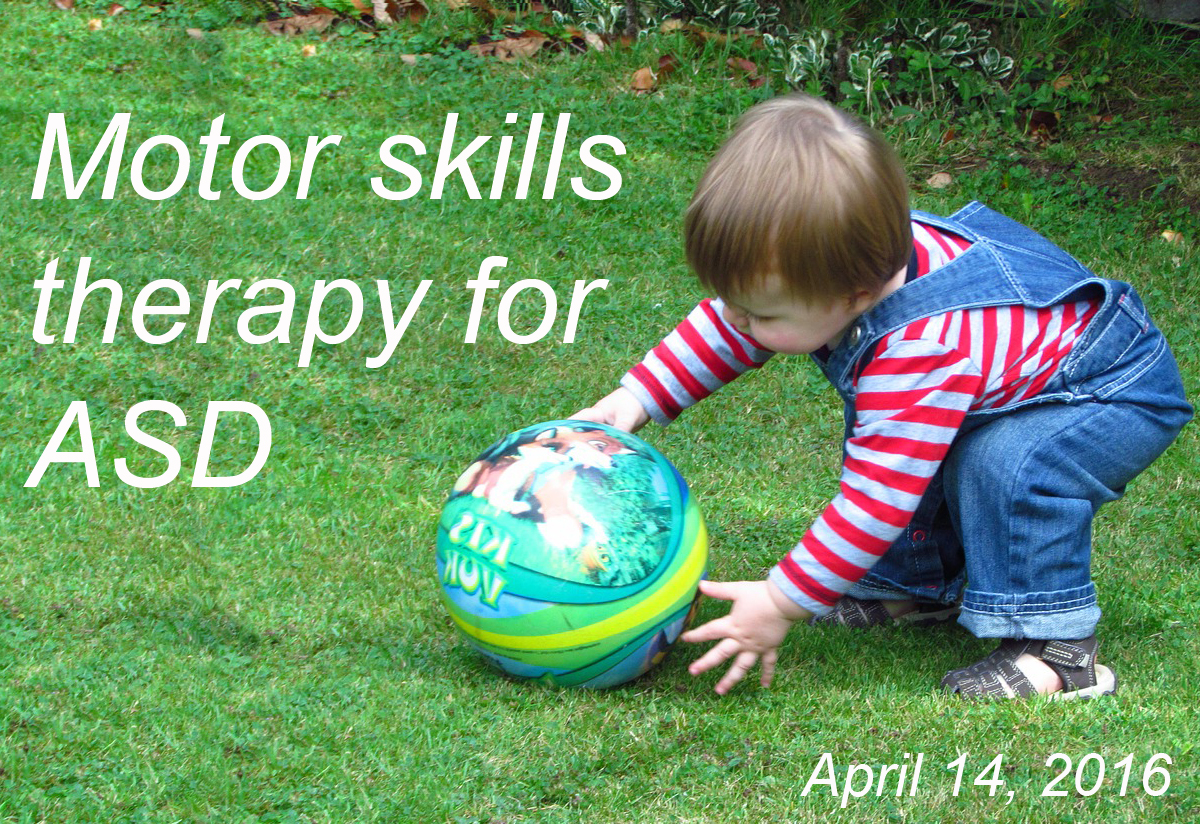
Background: Over 50 percent of children with autism have problems with gross and fine motor activities. Motor skills are often associated with playing sports or learning how to write, but they’re also important for imitation and synchronized movements. This social aspect of motor development is an important focus for autism research.
What’s new: On December 17, 2015, the journal Autism Research and Treatment published a study comparing motor performance following several therapies for autism. The researchers divided 36 children with Autism Spectrum Disorder into three groups—rhythm, robotic, and standard-of-care.
Each group received training for eight weeks, consisting of four sessions per week. The rhythm and robotic groups participated in social, whole-body movement games. In contrast, the standard-of-care group focused on tabletop activities that promoted fine motor skills, social communication, and academics.
The researchers found that children in the rhythm and robotic groups showed greater improvement on body coordination and movement synchrony, while the standard-of-care group improved their fine motor control.
Why it’s important: This is the first study to look at the effects of robotic and rhythm training compared to standard-of-care activities on social aspects of motor development using rigorous scientific methods. The results suggest that a combination of therapy is important for improving the range of motor skills needed for full functioning.
Help me understand :
| Source(s) : |
| Tweet |
Therapy with Robots May Help Social Skills in ASD
By Chelsea E. Toledo, M.A. on April 6, 2016
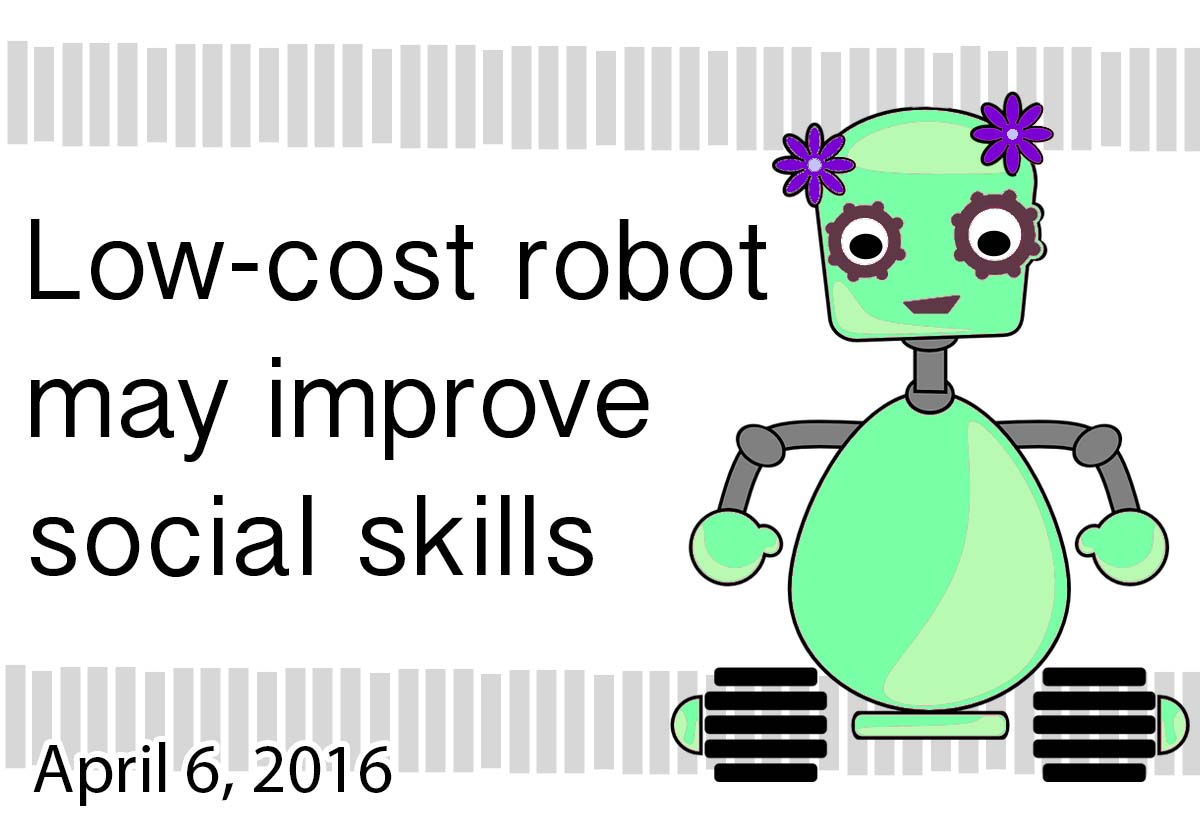
Background: Autism spectrum disorder (ASD) is characterized by differences in socialization, communication, and behavior. Novel approaches, such as robot-based interaction programs, are emerging as cutting-edge technologies for autism therapy.
What’s New: A recent issue of Autonomous Robot featured a study exploring whether incorporating robots into existing ASD therapies could further improve performance on assessments. The researchers administered speech therapy over a period of six weeks to 11 children between the ages of three and six with both ASD and language delay. Eight of those children also received interventions twice a week for 30 minutes each session with a robot invented by the researchers called Child Centered Adaptive Robot for Learning Environments, or CHARLIE, which could imitate the children’s movements and engage in games. They found that the group who interacted with CHARLIE showed greater improvement in receptive language, play and leisure scores on a commonly used assessment at the end of the study.
Why it’s important: This study suggests that interactions with robots may improve interactions with other people in children with ASD. Future research could further explore that possibility with a larger sample of children representing different ages and ASD severity.
Help me understand :
| Source(s) : |
| Tweet |
Sleep Meds May Make Behavior Worse in Autism
By Chelsea E. Toledo, M.A. on March 8, 2016
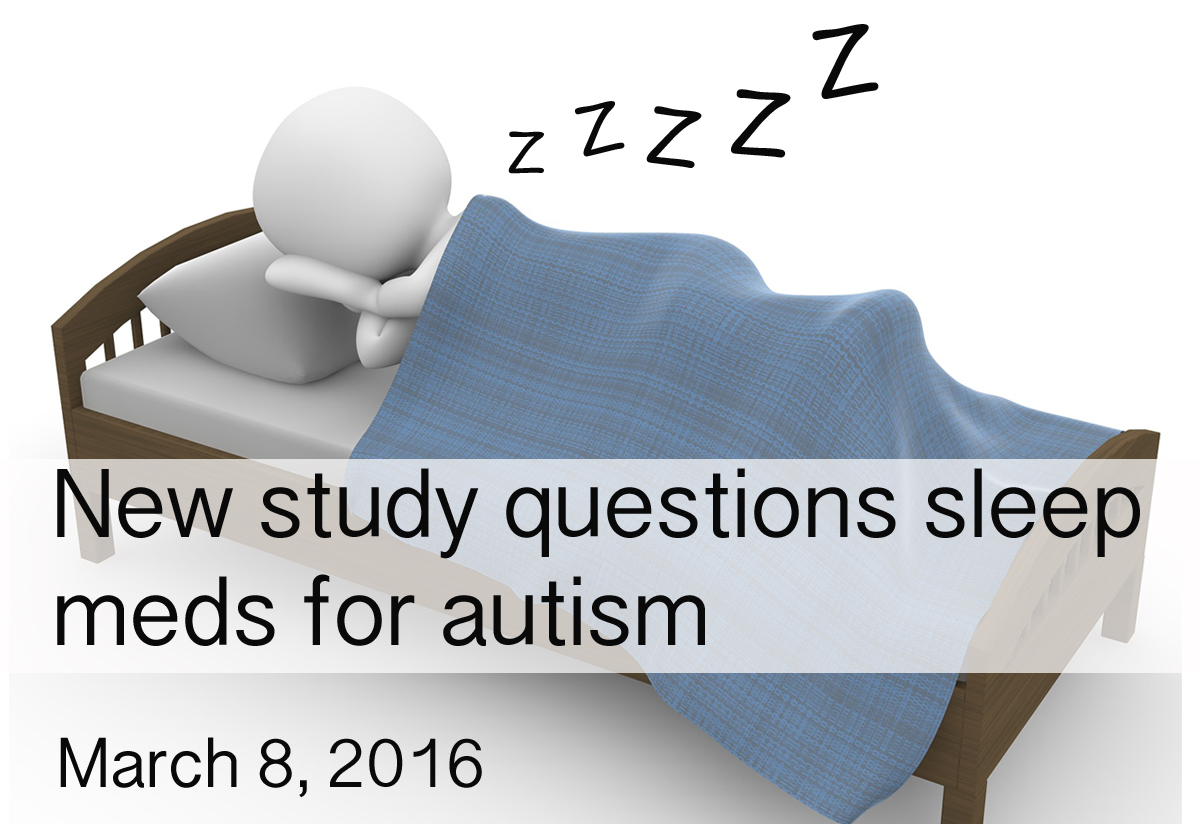
Background: Sleep disturbances are a common occurrence in children with autism spectrum disorder (ASD). Researchers have estimated that between 50 and 80 percent of people with the disorder experience difficulty sleeping.
What’s New: The February issue of Pediatrics included a study exploring the frequency of sleep difficulties and the use of sleep medications in children with autism. The researchers analyzed questionnaires from parents of 1518 children between the ages of four and ten who had been diagnosed with ASD. They found that – while only 30 percent of the children had a diagnosed sleep disorder – the scores of more than 70 percent of the children on a sleep habits questionnaire indicated significant sleep problems. In addition, the researchers found that the daytime behavior of the nearly 400 children prescribed sleep medications was reported to be worse than that of the children not taking sleep medications.
Why it’s important: This study underscores the need to screen for sleep problems during the diagnostic process for ASD. Future studies could investigate the underlying factors influencing the effects of sleep medications on this population to develop evidence-based recommendations for sleep treatments.
Help me understand :
| Source(s) : |
| Tweet |
Study Suggests Mobile App Helps Social Interaction
By Chelsea E. Toledo, M.A. on October 29, 2015

Background: Advances in mobile computing, such as iPad, hold promise as assistive or adaptive tools for individuals with autism spectrum disorder (ASD). Numerous ASD-related apps are commercially available. However, very few studies have rigorously tested their utility for improving social skills in people with the disorder.
What’s new: An upcoming issue of Association of Computing Machinery Transactions will include a study exploring the potential of a mobile app to improve social interaction in children with ASD. The researchers grouped eight children with ASD into four pairs, and alternated activities for each pair over a period of four weeks. The children had blocks to play with on weeks one and three and a two-player iPad game called Zody to play with on weeks two and four. Interviews conducted at the end of the four-week period suggested that the iPad game – which required players to take on collaborative roles – helped improve social interaction skills in the participants.
Why it’s important: This study may provide a proof of the principle that electronic assistive technologies can help improve social interactions in children with ASD. Future studies with larger participant groups could demonstrate this concept further and refine the use of specific assistive technologies.
Help me understand :
| Source(s) : |
| Tweet |
UK Study Finds Predictors for Antipsychotic Use in ASD
By Shana R. Spindler, PhD on October 22, 2015
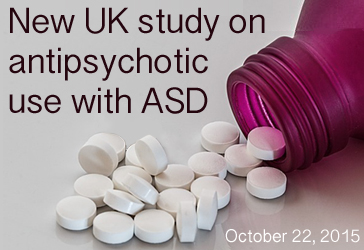
Background: About one tenth of children with autism spectrum disorder (ASD) in Europe receive antipsychotic medication. In the United States, that fraction climbs to one third. To date, two drugs—risperidone and aripiprazole—are are approved by the FDA to treat irritability in children with ASD, but little is known about antipsychotic use for other co-occurring conditions.
What’s new: On October 15, 2015, the journal European Child & Adolescent Psychiatry published a study detailing antipsychotic use in children with ASD. United Kingdom (UK) researchers examined medical records for 3,482 UK children diagnosed with ASD between 2008 and 2013. They found that children with ASD in the UK who were hyperkinetic, psychotic, depressive, obsessive compulsive, or who had tic disorders were more likely to take antipsychotic medications. Antipsychotic prescription also followed higher levels of aggression, self-injurious behaviors, poor general functioning, and increased parental concern for the child’s symptoms.
Why it’s important: To date, this is the largest study to correlate antipsychotic use with ASD and co-occurring conditions. An overarching goal with studies like these is to give clinicians the necessary tools to predict who might benefit most from available therapy options. Additionally, the results of this study may inform clinical trial design, as clinical trials frequently omit children with any comorbid conditions.
Help me understand :
| Source(s) : |
| Tweet |
Repetition May Impair Learning in Autism, Study Finds
By Chelsea E. Toledo, M.A. on October 15, 2015
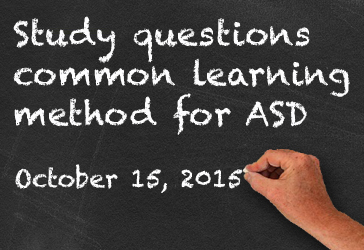
Background: Cognitive flexibility refers to the ability to shift one’s thinking in response to a change in stimuli. Studies have shown that people with autism spectrum disorder (ASD) often struggle with cognitive flexibility. For example, after successfully completing a drill of identifying an object in a picture, individuals with ASD don’t always transfer that knowledge when asked to identify the same object in another picture.
What’s New: On October, 2015, the journal Nature Neuroscience published a study exploring the roots of cognitive inflexibility as it relates to ASD. The researchers administered a test to 23 high-functioning adults with ASD and 19 typically developing controls, asking them to locate a set of diagonal bars among horizontal bars on a screen multiple times over a period of eight days, with the location of the target switching on the fifth day. The ASD group performed similarly to the control group over the first four days, but not on days five through eight. However, a second group of participants and controls underwent a similar test – only with “dummy” screens shown in between tasks – and the ASD group did not experience the same dip in performance when the target switched locations.
Why it’s important: This study suggests that, while repetition may be an effective way to teach a single concept, repeated stimuli may in fact derail longer-term learning for people with ASD. Future studies could lay the groundwork for less repetitive learning models to aid in the education of people with ASD.
Help me understand :
| Source(s) : |
| Tweet |
Luteolin May Improve Behavior in ASD Subgroup
By Shana R. Spindler, Ph.D. on October 8, 2015

Background: Individualized management is an important goal for those with Autism Spectrum Disorder (ASD). While we don’t yet have standardized ASD subgroups, several lines of evidence suggest that inflammatory molecules may serve to distinguish some ASD populations.
What’s new: On September 29, 2015, the journal Translational Psychiatry published a study on the effect of luteolin supplementation on children with ASD. The antioxidant luteolin is a powerful anti-inflammatory agent naturally found in some foods, including celery, broccoli, and navel oranges. The researchers found that a subgroup of children with ASD had high blood levels of inflammatory molecules—known as IL-6 and TNF—which decreased significantly after luteolin treatment. The children with the greatest decrease in IL-6 and TNF showed the most improvement in communication, daily living skills, and social behaviors.
Why it’s important: This study combines two important topics in autism research: subgroup identification and individualized treatment. An inflammation-based biomarker in individuals with ASD could help predict prognosis following anti-inflammatory treatments. The results of this study support the need for a larger, double blind, randomized, placebo-controlled trial.
Help me understand :
| Source(s) : |
| Tweet |
Digestive Enzyme Supplement May Improve ASD Symptoms
By Shana R. Spindler, Ph.D. on August 18, 2015
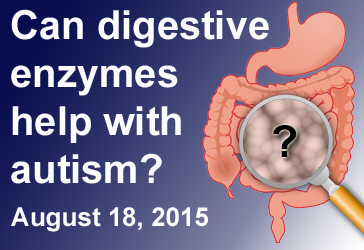
Background: Gastrointestinal ailment is frequently observed in individuals with Autism Spectrum Disorder (ASD). Several studies have shown that individuals with ASD may lack proper digestive enzymes, such as lactase—an enzyme that helps digest the lactose in dairy products. One theory is that undigested nutrients may contribute to some of the core symptoms of autism and any co-occurring gastrointestinal distress.
What’s new: On August 31, 2015, the journal Clinical Psychopharmacology and Neuroscience published a randomized, double-blind, placebo-controlled study investigating the benefits of digestion enzyme supplementation for children with ASD. The researchers gave 92 children with ASD between 3 to 9 years of age either a combo of gastric enzymes (papain and pepsin) or a sugar syrup placebo, to be taken at each meal. After three months, the group receiving the enzymes showed significant improvement in emotional response, general behavior (mainly improved restrictive, repetitive, and stereotypic behavior), and gastrointestinal symptoms.
Why it’s important: This study supports the need for a larger, randomized, double-blind study of digestive enzymes for children with ASD. According to the authors, digestive enzymes are inexpensive, readily available, and safe for use.
Help me understand :
| Source(s) : |
| Tweet |
Study Questions Gluten- and Casein-Free Diets for ASD
By Chelsea E. Toledo, M.A. on July 23, 2015
Background: Autism Spectrum Disorder (ASD) has been linked to gastrointestinal issues, and some families follow specific dietary guidelines to allay both digestive and behavioral symptoms. In particular, these diets have excluded gluten and casein—proteins found in bread and milk, respectively. While some healthcare professionals recommend a gluten-free, casein-free diet—commonly known as a GFCF diet—studies that confirm its efficacy are lacking.
What’s New: On July 4, 2015, the journal Acta Paediatrica published a study exploring the effects of gluten and casein on the gastrointestinal and behavioral symptoms of children with ASD as well as the urine concentration of a protein previously associated with behavioral issues in autistic children. The researchers performed a double-blind, randomized clinical study on children between the ages of 4 and 7 with severe behavioral issues related to ASD, all of whom were already on a gluten- and casein-free diet. After giving a gluten-casein supplement to 38 children and a rice meal placebo to 36 children for one week, they found no significant difference between the two groups in behavior, urinary protein expression, and level of gastrointestinal disruption.
Why it’s important: While previous studies have evaluated the effects of eliminating gluten and casein from the diets of children with ASD, this is the first study to explore the results of adding the proteins back in. Future studies could evaluate the long-term effects of gluten and casein on behavior and gastrointestinal symptoms, given the limited exposure time to these proteins in this study.
Help me understand :
| Source(s) : |
| Tweet |
Omega-3 Fatty Acids Fail to Improve ASD Symptoms
By Shana R. Spindler, Ph.D. on April 8, 2015

Background: According to a 2006 study, nearly 30 percent of children with autism use some form of omega-3 fatty acid supplementation. Omega-3 fatty acids are a special type of polyunsaturated fatty acid. They are highly concentrated in fish (in the form of DHA and EPA) and some plants (in the form of ALA), but can be taken in pill or oil form too. Because DHA is a critical factor in brain growth and development, research groups have investigated if omega-3 fatty acid supplementation can improve ASD symptoms.
While several studies report a decrease in hyperactivity among children who take omega-3 fatty acid supplements, in no study was this correlation significant. Adding to the confusion, many studies were very small and lacked randomized, double blind controls. Yet, despite a lack of scientific evidence showing effectiveness, omega-3 fatty acid use remains a staple in the ASD complementary and alternative treatment toolkit.
What’s new: On March 21, 2015, the online journal Molecular Autism published a study on DHA plus EPA supplementation for children (two to five years of age) with ASD in a randomized, double blind, placebo-controlled study. The researchers found no significant difference in core or associated symptoms between children receiving DHA and EPA versus placebo. They did, however, find a significant worsening of externalizing behaviors in the DHA plus EPA group. The researchers hypothesize that exacerbation of underlying gastrointestinal issues in the omega-3 fatty acid group may account for the significant worsening of externalizing behaviors.
Why it’s important: This study clearly indicates the lack of significant correlation between omega-3 fatty acid supplementation and ASD symptom improvement. The study also suggests that omega-3 fatty acid supplementation may worsen externalizing behaviors in children with co-occurring gastrointestinal issues, but this observation requires replication before conclusions can be made.
Help me understand :
| Source(s) : |
| Tweet |
Behavioral Training May Normalize Brain Dysfunction
By Chelsea E. Toledo, M.A. on February 25, 2015
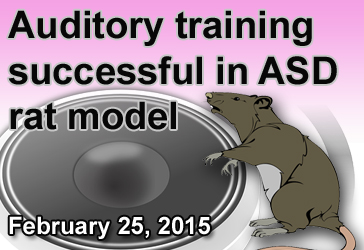
Background: Research suggests that both genetic and environmental factors play a role in the development of autism spectrum disorder (ASD), which is characterized by differences in brain function and behavior. Multiple studies have pointed to antidepressants as a possible environmental factor, proposing that exposure to the drugs in the weeks before and after birth could induce ASD symptoms in children. In some animal models of autism, researchers expose rats to antidepressants to mimic the behavioral effects seen in children.
What’s new: On February 2, 2015, the journal Proceedings of the National Academy of Sciences published a study examining the effects of behavioral training on rats exposed to antidepressants shortly after birth. The researchers found that the rats behaved similarly to children with ASD—preferring to play alone than with other rats, for example. Using a set of sounds shown to drive changes in the brain in typically developing animals, the researchers observed that, at first, rats exposed to antidepressants scored poorly on cognitive tests—and had underlying brain dysfunction. Over the course of two months—the rough equivalent of two years for people—the rats continued the auditory training and showed significant improvement in their behavioral responses and some reversal of their brain dysfunction, as well.
Why it’s important: The effect of antidepressant exposure affected male rats much more than females—a pattern that mirrors the prevalence of ASD in the human population, in which boys are four times more likely than girls to receive a diagnosis. The study also positions behavioral training that targets brain function as a possible therapy for children with ASD.
Help me understand :
| Source(s) : |
| Tweet |
Oxytocin Improves Eye Contact
By Sharmila Banerjee-Basu, Ph.D. on February 18, 2015
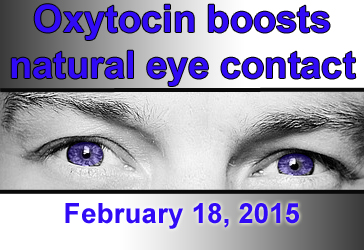
Background: Oxytocin is a hormone produced in the brain with diverse physiological functions: labor contractions during childbirth, lactation, and sexual intimacy. More recently, scientists have examined oxytocin’s role in mediating social behaviors across mammalian species, including human. At present, oxytocin is an attractive pharmaceutical candidate for disorders of social cognition such as autism spectrum disorder (ASD).
What’s new: In a study published online, February 10, 2015, in the journal Molecular Psychiatry, scientists at University of Cambridge, UK, reported the effect of oxytocin in improving eye contact in a real-word social situation in adults with autism. The researchers administered an intranasal spray consisting of either oxytocin or placebo (same formulation without oxytocin), in a double-blinded manner, to 32 adult males with ASD and 34 neurotypical control participants. A novel test for social interaction – recording eye movements in a naturalistic setting – indicated that oxytocin significantly improved eye contact in both the ASD and control population. Importantly, oxytocin had a greater effect on looking time in ASD individuals with poor eye contact than in the placebo condition.
Why it’s important: Ongoing clinical trials are testing if therapeutic oxytocin can alleviate social cognition difficulties in children and young adults with ASD. This is the first study to show improvement of a core behavioral component of autism: eye contact in a social situation.
Help me understand :
| Source(s) : |
| Tweet |
Group Classes for Parents Yield Gains for Children
By Chelsea E. Toledo, M.A. on November 25, 2014
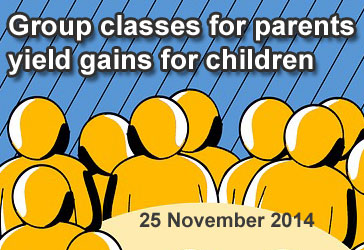
Background: Pivotal Response Treatment (PRT) is a child-led, play-based intervention intended to address target—or “pivotal”—areas of a child’s development, including motivation and initiation of social interactions. By focusing on these areas, PRT aims to induce broad social, behavioral, and communicative improvements in children with Autism Spectrum Disorder (ASD).
What’s new: On October 27, 2014, the Journal of Child Psychology and Psychiatry published the first-ever randomized controlled trial evaluating the effectiveness of PRT when administered by parents undergoing group training to deliver the intervention. A total of 53 children with ASD—aged two to six—participated in the study. Over the course of twelve weeks, parents of 27 children underwent group training to administer PRT in their homes, while the parents of the remaining 26 learned general information about ASD. Laboratory observations showed significant improvement in the number of utterances—such as saying “ball” to receive a ball—by children whose parents underwent PRT training.
Why it’s important: This study suggests that parents can become effective administrators of PRT after undergoing group classes—an efficient medium for disseminating information to a large number of affected families. Future studies could better examine PRT impact on social skills and determine the ideal balance of clinical interventions and at-home therapy.
Help me understand :
| Source(s) : |
| Tweet |
Chemical in Broccoli Sprouts May Inform ASD Treatment
By Chelsea E. Toledo, M.A. on October 24, 2014
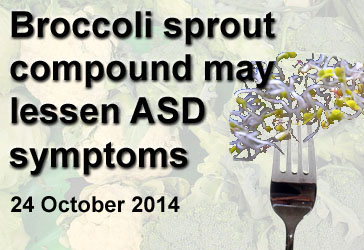
Background: No approved pharmacological treatment exists for the core symptoms of Autism Spectrum Disorder (ASD), which include impaired communication, difficulties with social interaction, and repetitive behaviors. However, some naturally occurring chemicals have been shown to address biochemical irregularities – such as oxidative stress – that are associated with ASD.
What’s new: On October 13, the Proceedings of the National Academy of Sciences published a double-blind study investigating the potential of sulforaphane – a chemical present in vegetables like broccoli sprouts, kale, and bok choy – to ameliorate autism symptoms. The researchers gave sulforaphane supplements extracted from broccoli sprouts to 29 young men between the ages of 13 and 27 over a period of 18 weeks, and compared them to a group of 15 men receiving a placebo. After 18 weeks, the group receiving sulforaphane showed significant improvement in their scores on three different behavioral assessments administered by caregivers and physicians, while the control group experienced little change. The researchers then stopped treatment and continued to observe both groups for four additional weeks, noting that their scores returned to the baselines established before treatment began.
Why it’s important: While many clinical studies aim to control ASD-related behaviors directly, this study addressed the suspected underlying biochemical abnormalities instead. Future studies could delve deeper into the possible benefits of sulforaphane – for instance, whether it can provide early treatment for young children with ASD diagnoses or if it might prevent ASD when taken as a prenatal supplement.
Help me understand :
| Source(s) : |
| Tweet |
Very Early Therapy Eases ASD Symptoms, Study Suggests
By Shana R. Spindler, PhD on September 16, 2014

Background: While many children with autism are diagnosed during their late toddler and preschool years, there is an ongoing attempt to identify very early signals, such as lack of eye contact, even during infancy. Newer studies are now focusing on treatment for infants suspected of having autism or being at increased risk for the disorder.
What's new: Researchers at the University of California, Davis, MIND Institute report a promising behavioral therapy for Autism Spectrum Disorder (ASD), called Infant Start. Based on the Early Start Denver Model, Infant Start is a parent-led behavioral intervention that emphasizes parent-child social interactions from infancy.
Symptomatic infants between seven and 15 months of age, and their parents, participated in a 12-week, low-intensity pilot program. During weekly sessions, highly trained therapists coached parents in individualized behavioral therapies, which parents continued in the home environment. By 18 months, the children who participated in Infant Start had significantly fewer autism symptoms than the children of families who chose not to enroll in the pilot study.
Why it's important: This study supports the idea that early treatment for autism may alleviate some of the core symptoms associated with the disorder, as seen in previous studies on toddler-age children.
Help me understand :
| Source(s) : |
| Tweet |
Virtual Reality May Ease Fears in Autistic Youth
By Chelsea E. Toledo, M.A. on August 25, 2014

Background: Anxiety is one of the most common conditions to occur alongside Autism Spectrum Disorder (ASD) in children and adolescents with the disorder. The condition can manifest in the form of specific phobias, such as fear of riding in cars or fear of birds. These phobias can interfere with daily life and exacerbate the core symptoms of ASD.
What’s New: On July 2, 2014, the digital journal PLOS ONE published a paper evaluating an emerging technique to address anxiety in young people with ASD. For the study, nine boys aged 7 to 13 underwent cognitive behavioral therapy (CBT)—an existing treatment approach shown to reduce anxiety associated with ASD—together with five sessions in a proprietary virtual reality environment (VRE). Anxiety questionnaires administered periodically in the 16 months following the treatment revealed that eight of the nine participants were newly able to tackle their specific phobias, and four overcame them completely.
Why it’s important: This study lends support to previous findings that CBT can be effective in reducing anxiety in young people with ASD. Importantly, a combination therapy of CBT and VRE could be more effective than a single therapy. Future research using a control group could validate CBT in conjunction with VRE as an effective therapy to address specific phobias.
Help me understand :
| Source(s) : |
| Tweet |
Study Finds Promise for Steroids in Regressive Autism
By Shana R. Spindler, PhD on July 31, 2014
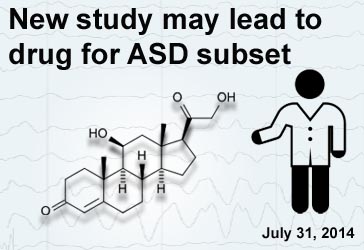
Background: About a third of children with Autism Spectrum Disorder (ASD) experience a period of normal early development followed by loss of previously acquired language and social skills. While no evidence-based treatments exist for this type of regressive autism (R-ASD), some doctors have reported that corticosteroid use improves language and behavior scores. Corticosteroids are chemicals that mimic hormones naturally produced by the body. They act by suppressing inflammation and the immune system.
What’s new: From a large database of patients, researchers identified twenty children who had received steroid treatments to investigate if corticosteroids benefit children with R-ASD. Twenty four non-treated ASD children were used for comparison. Their study found that children with R-ASD who had received corticosteroids showed greater improvement in language and social skills than those who did not receive steroid treatment. The researchers also found that corticosteroids increased activity in an area of the brain known for auditory processing and the perception of emotions.
Why it’s important: While this study was a small retrospective (the researchers used data from previously acquired measurements), it indicates a need for a larger controlled study of corticosteroid treatment for R-ASD with appropriate controls. The most common adverse effects from corticosteroids in this study included weight gain and difficulty in managing the child’s behavior.
Help me understand :
| Source(s) : |
| Tweet |
Link Between Oxytocin And Serotonin May Inform Therapy
By Wayne Pereanu, PhD on June 25, 2014
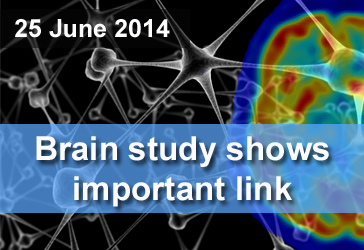
Background: Previous work has shown that some individuals with Autism Spectrum Disorder (ASD) have altered levels of oxytocin and serotonin, chemical messengers in the brain that regulate human emotion and behavior. Recent work in animal models has suggested that oxytocin influences the amount of serotonin produced. While this work in animals is suggestive, there have been no comparable studies in humans.
What's New: In the June 2014 issue of the Proceedings of the National Academy of Sciences, researchers report that oxytocin regulates the level of serotonin in the brains of neurotypical individuals. The researchers administered oxytocin through the nose in half of the participants (the other half got a placebo). The group then injected study participants with a tracer compound that allows researchers to infer levels of serotonin in the participants’ brains using PET, a type of specialized brain scan. The team found that oxytocin application induced a decrease in the amount of serotonin in four brain areas that are thought to be important for emotion-based behavior.
Why it's important: Drugs that alter levels of either oxytocin or serotonin are currently used to treat various ASD-associated symptoms. This study is the first to show that oxytocin levels can decrease the amount of serotonin in human brains. While this supports previous animal studies, it is an important and requisite step to show this in humans. Their findings suggest that treatment of oxytocin and serotonin levels should be coordinated.
Help me understand :
| Source(s) : |
| Tweet |
Researchers Explore ASD and GI Symptoms Link
By Chelsea E. Toledo, M.A. on May 8, 2014
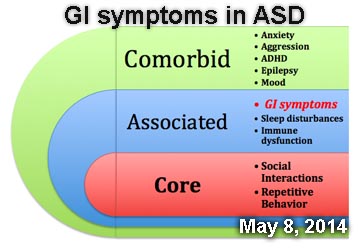
Background: For over thirty years, researchers have suspected a link between Autism Spectrum Disorder (ASD) and gastrointestinal (GI) symptoms. The GI symptoms frequently reported in ASD include abdominal pain, constipation, chronic diarrhea, and gastroesophageal reflux disease. Recently, The National Institutes of Health has prioritized research exploring GI symptoms in people with ASD.
What’s new: On May 2, 2014, the journal Pediatrics published a meta-analysis of GI symptoms in ASD, examining 15 studies conducted between 1980 and 2012. In all, the analysis included data from 2215 children with ASD, whose GI indicators were compared to those in children without ASD. The researchers found that, when all studies were taken into consideration, children with ASD were much more likely than their typically developing counterparts to experience general GI symptoms—as well as specific symptoms such as diarrhea, constipation, and abdominal pain.
Why it’s important: This study is the first thorough evaluation of the evidence suggesting that GI dysfunction is more common in children with ASD. More research is needed to determine why GI symptoms appear more common in people with ASD, as well as their long-term effects.
Help me understand :
| Source(s) : |
| Tweet |
Oxytocin Ups Social Brain Activity in Children with ASD
By Chelsea E. Toledo, M.A. on December 10, 2013

Background: Oxytocin is a hormone most commonly associated with childbirth and lactation, and recent studies have explored its role in maternal, romantic, and social bonding. For instance, when given oxytocin through the nose, typically developing adults showed improvement in eye contact, trust, and reading emotions from facial expressions.
What’s New: On December 2, 2013, the Proceedings of the National Academy of Science (PNAS) published a paper exploring the cognitive effects of oxytocin in children with autism spectrum disorder (ASD). In a randomized, double-blind study, the researchers assigned 17 children aged eight to 16.5 to receive a single oxytocin nasal spray or a placebo. Brain scans of children in the treatment arm showed increased activity in certain areas of the brain when the researchers asked them to assess expression in photos of eyes. The brain areas with increased activity included those associated with motivation, higher information processing, sleep, decision-making, and social perception. Activity of the same brain areas decreased in participants who received oxytocin when they were asked to categorize images of automobiles.
Why it’s important: While it used a small sample size, this study demonstrates that therapeutic oxytocin might help children with ASD respond more appropriately to social versus non-social stimuli.
Help me understand :
| Source(s) : |
| Tweet |
Up Antioxidant Activity To Improve Behavior, Study Says
By Shana R. Spindler, Ph.D. on December 2, 2013
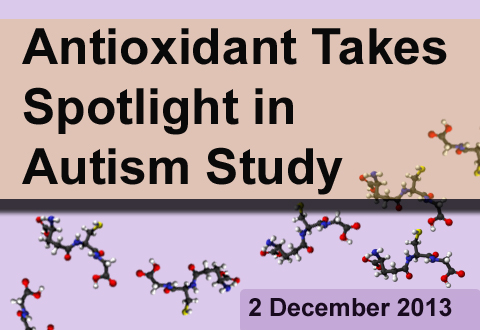
Background: Some children with autism have deficits in antioxidant activity, which normally detoxifies cells. An antioxidant is a molecule that is capable of neutralizing damage causing free radicals—most people know of the antioxidant Vitamin C. Glutathione is another antioxidant, and it is lower in some people with autism. Antioxidant protection is critical for the immune system and neurons, which are particularly susceptible to cellular damage.
What’s new: Researchers at Arkansas Children’s Hospital Research Institute report that nutritional supplementation aimed at increasing glutathione activity improves autism-related behaviors. In the study, 40 children with autism who had low levels of active glutathione received supplements of methylcobalamin and folinic acid, factors in glutathione production and activation. After three months, changes in blood levels of active glutathione correlated with increased scores on behavior measurements. The children made large gains in expressive communication, daily living skills, and various social skills. Thirty-seven children completed the study with minimal side effects, mostly hyperactivity and reduced sleep.
Why it’s important: Two key points stand out from this study. First, antioxidant levels may serve as a useful biological marker for a subset of autism. Second, nutritional supplementation may indeed help children who fall within this category. This preliminary study warrants further investigation with a randomized, double blind trial.
Help me understand :
| Source(s) : |
| Tweet |
Parent Training May Improve Autistic Children’s Diet
By Chelsea E. Toledo, M.A. on October 18, 2013
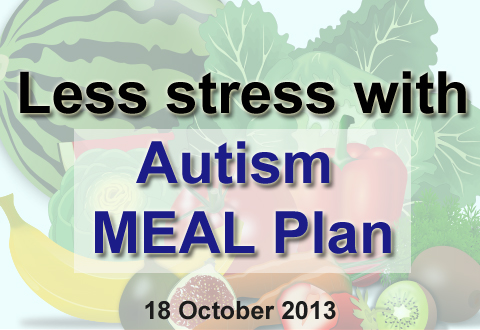
Background: Anecdotal evidence demonstrates that children with Autism Spectrum Disorder (ASD) often have problems maintaining a regular diet, and studies suggest that this population is at a greater risk for nutritional issues—including vitamin deficiencies, poor bone growth, and obesity.
What’s New: On October 7, 2013, the journal Autism published a pilot study evaluating a curriculum for parents to address feeding issues in children with ASD. The program, called the Autism MEAL Plan, was administered over eight training sessions and covered behavior management strategies, specific interventions for ASD-associated feeding issues, and tactics to promote self-feeding. 30 families began the study, completing a series of evaluations to assess dietary issues, general health, and stress experience by parents. Of the 19 families continuing on with the study, 10 completed Autism MEAL Plan training, reporting a significant reduction in parental stress as compared to the control group. However, no significant differences between groups existed regarding feeding behaviors and dietary variety following the intervention.
Why it’s important: This study provides preliminary evidence to support parental training programs for the sake of improving meal time for children with ASD. However, because so few families participated, further research is needed to provide conclusive results.
Help me understand :
| Source(s) : |
| Tweet |
Mind-Body Training Helps Autistic Children’s Self-Control
By Chelsea E. Toledo, M.A. on September 19, 2013
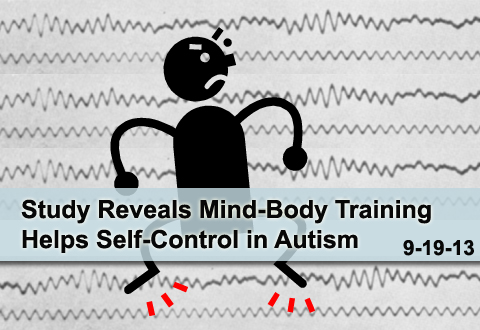
Background: Children with autism spectrum disorder (ASD) are known to experience difficulty with self-control – which manifests as temper tantrums and repetitive, rigid, or impulsive behaviors. If self-control difficulties are not addressed, additional learning problems can follow. Most existing interventions to improve self-control use behavior-based therapy.
What’s New: On July 10, 2013, a study published in the online journal PLOS ONE demonstrated that a Chinese mind-body exercise could improve self-control in children with ASD. Forty-six children between the ages of 6 and 17 with the disorder were divided into two groups, matching them based on their age an IQ. For four weeks, the control group practiced Progressive Muscle Relaxation (PMR), a conventional behavioral intervention technique, while the experimental group underwent training in Nei Yang Gong, a holistic Chinese approach including psychoeducation, diet modifications, and mind-body exercises. The researchers found that children participating in Nei Yang Gong scored better than the control group on neurophysical tests, parental questionnaires, and electroencephalography (EEG) brain activity recordings measuring self-control.
Why it’s important: This study reveals the potential benefit of Chinese mind-body training for children with ASD.
Help me understand :
| Source(s) : |
| Tweet |
Playwisely Program Improves Sensory-Based Skills
By Shana R. Spindler, Ph.D. on September 13, 2013
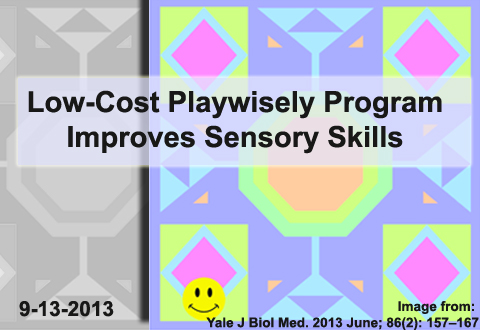
Background: Autism insurance coverage varies greatly. Given the high cost of some autism therapies, middle and low-income families have limited treatment options. Researchers are working to find cost-effective autism therapy.
What’s new: The Playwisely Program is a low-cost system designed to promote connections between sensory areas of the brain. The program uses interactive flashcards that mix sight, sound, and touch. Researchers from the Autism Treatment Center in Dallas, Texas, divided 18 children with mild to severe autism into two treatment groups: Playwisely or usual care. The researchers found that Playwisely improves multiple skills in ASD after three months. They reported significant improvements in recognition, sensory mixing, speech sound awareness, letter recognition, and early memory skills. The small sample size prevented some study comparisons, such as Playwisely benefits for specific age groups.
Why it’s important: The authors of the study estimate that Playwisely is one-tenth the cost of available alternatives. This makes Playwisely an attractive option for all families, regardless of income. A major strength to this study is that clinicians made post-treatment assessments in a blind manner. This means the clinician did not know if the child was part of the Playwisely or usual care group.
Help me understand :
| Source(s) : |
| Tweet |
New Tool Provides Potential Screening and Treatment
By Chelsea E. Toledo, M.A. on August 9, 2013

Background: Most assessments for autism spectrum disorder (ASD) are based on a person’s behavior. However, children with ASD are known to display unpredictable patterns of physical movement—a possible target for more personalized autism screening and therapy.
What’s New: On July 24, 2013, the journal Frontiers in Integrative Neuroscience featured a set of studies exploring physical movements as a target for assessing and treating ASD. In the first study, the researchers assessed how 34 individuals with ASD and 44 typically developing control subjects followed cues to point at objects on a screen over a series of trials. They found disruptions in the progress of individuals with ASD as trials ensued. In the second study, the researchers tested the ability of 25 individuals with ASD and 8 control subjects to hold an arm within a desired area. They found that, when provided a reward—the chance to watch an enjoyable video, autistic subject’s movements became more predictable, suggesting that self-discovery tasks can improve anticipatory behavior.
Why it’s important: Fifteen years ago, Teitelbaum et al. showed movement disturbances as integral component of autism that could be clearly detected as early as 4 – 6 month old infants. These two new studies could bring the value of movement analysis in evaluating ASD to the forefront.
Help me understand :
| Source(s) : |
| Tweet |
Antioxidant + Risperidone, Promising Irritability Treatment
By Shana R. Spindler, Ph.D. on August 1, 2013
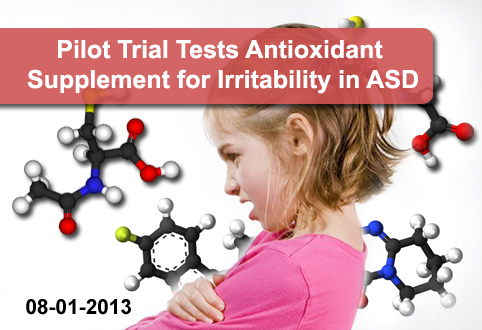
Background: Glutathione, an antioxidant that protects cells from oxidative stress, is reduced in patients with autism spectrum disorder (ASD). Some researchers propose that an imbalance of antioxidant protection versus oxidative stress plays a role in autism. Clinical trials are underway to assess the therapeutic potential of antioxidant therapy in children and adolescents with ASD.
What’s New: An eight-week study of 40 children with ASD found that children who received the antioxidant N-Acetylcysteine (NAC)—a precursor to glutathione—in addition to risperidone therapy had less irritability than children on risperidone alone. The researchers reported only mild adverse effects from NAC supplements. Side effects included constipation, increased appetite, fatigue, nervousness, and daytime drowsiness. Other social and behavioral aspects of ASD did not improve with the addition of NAC.
Why it’s important: A larger and longer trial is needed to confirm the improved irritability scores. The researchers also do not know if irritability returns upon the discontinuation of NAC supplementation. As a pilot trial, the results of this research offer a promising direction to pursue.
Help me understand :
| Source(s) : |
| Tweet |
Mouse Model Supports IGF-1 Treatment Investigations
By Shana R. Spindler, Ph.D. on July 18, 2013
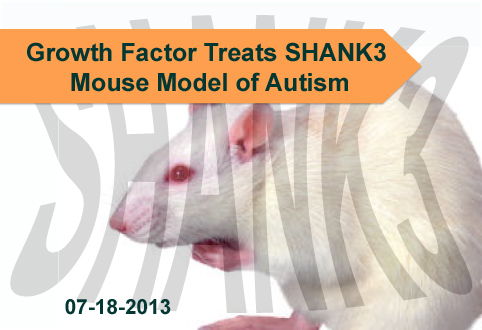
Background: Researchers have linked a small fraction of autism spectrum disorder (ASD) cases to mutations in SHANK3, a gene that codes for a scaffolding protein found at neural connections known as synapses. In mice, disruption of the Shank3 gene leads to neural signaling deficits, a decreased ability to alter synapses in response to experiences (a process known as long-term potentiation), and motor abnormalities.
A drug that can address synaptic disruption from SHANK3 mutations may be of benefit to a sub-population of people with ASD. Insulin like growth factor-1 (IGF-1), an approved drug for short stature in children, can enter the central nervous system to mediate synaptic development and activity and has shown promise in previous mouse and human studies of Rett syndrome.
What’s new: In a new study, researchers from the School of Medicine at Mount Sinai in New York, NY tested the effect of IGF-1 injections into a mouse model harboring an autism-linked disruption in one copy of the Shank3 gene. After daily injections for two weeks, mice showed improved neural signaling, restored long-term potentiation, and enhanced motor performance. This study was published April 27, 2013 in Molecular Autism.
Why it’s important: A double-blind clinical trial to study the safety and efficacy of IGF-1 treatment in children who have a SHANK3 gene deficiency and ASD is currently underway. Researchers do not fully understand how IGF-1 reverses the synaptic deficits observed with disruption of SHANK3.
Help me understand :
| Source(s) : |
| Tweet |
Autism Linked to Differences in Gut Microbes
By Chelsea E. Toledo, M.A. on July 10, 2013
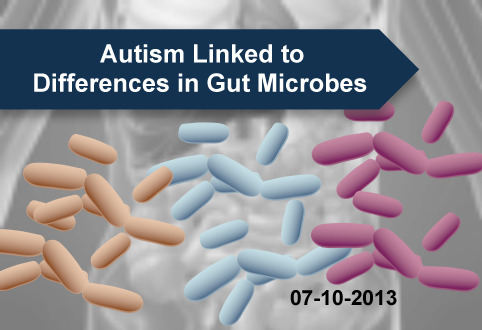
Background: Inside the human gut, communities of benign microbes thrive, aiding in digestion. Studies have demonstrated that gastrointestinal (GI) issues often arise in people with autism spectrum disorder (ASD), but very few have examined how variability in so-called “good bacteria” in the gut might contribute to that trend.
What’s New: On July 3, 2013, the online journal PLOS ONE featured a study examining systematic changes in gut microbes as they related to ASD and accompanying GI problems. The researchers administered a survey to 40 children between the ages of three and 16 to assess symptoms of GI issues and ASD. They then took fecal DNA samples, which revealed that the children who had reported ASD symptoms had less diversity in their gut microbes than their typically developing counterparts, with significant and systematic reduction of certain carbohydrate-degrading and/or fermenting bacteria.
Why it’s important: This study demonstrated that the presence of ASD symptoms—as opposed to the symptoms of GI problems—was linked to specific irregularities in gut microbe composition. The finding could inform future research to diagnose and formulate dietary interventions for treating ASD.
Help me understand :
| Source(s) : |
| Tweet |
Risperidone-Associated Weight Gain Linked to Genetics
By Shana R. Spindler, Ph.D. and Chelsea E. Toledo, M.A. on July 3, 2013
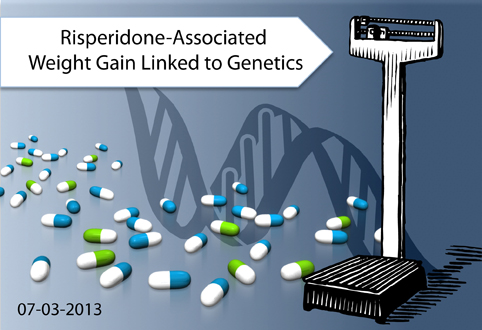
Background: Risperidone is an atypical antipsychotic drug that acts by blocking the brain’s receptors for the chemicals serotonin and dopamine. While risperidone has been approved to treat schizophrenia and bipolar disorder since 1993, in 2006 the FDA deemed it an acceptable therapy for irritability in children and adolescents with autism spectrum disorders (ASD). Unfortunately, some patients experience antipsychotic-induced weight gain while using risperidone, but little is known about the variability of this symptom.
What’s New: A new study published 25 June 2013 in the journal Translational Psychiatry suggests that risperidone-induced weight gain is influenced by genetic factors. Researchers examined common genetic variations in “energy balancing” genes in 225 patients, aged 4-17 years. These patients belonged to the National Institute of Mental Health (NIMH) Research Units on Pediatric Psychopharmacology (RUPP) Autism Network trials of risperidone for the treatment of irritability in children and adolescents with ASD. Specific genetic variants affecting Cannabinoid Receptor-1 and Leptin, two proteins known to influence feeding behavior and weight, resulted in increased risk for weight gain with the use of risperidone.
Why it’s important: Adverse side effects from pharmaceutical treatments are of important concern. Understanding the genetic and environmental risk factors for side effects can help doctors develop more personalized treatments and improve clinical outcomes.
Help me understand :
| Source(s) : |
| Tweet |
Animals Postively Influence Children With Autism
By Stacy W. Kish on April 16, 2013
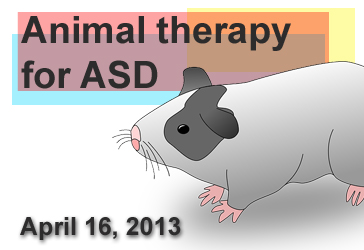
Background: Previous studies report that an animal can moderate stress in people. Children diagnosed with Autism Spectrum Disorder (ASD) often experience problems socializing with their peers and adults, leading to stressful interactions like bullying. A new study examines how animal interaction in the classroom environment benefits ASD children.
What’s new: Researchers at the University of Queensland, Brisbane, Australia evaluated the effect of guinea pigs or motivating toys in socialization of ASD children with their typically developing peers. The researchers found the ASD children spoke to their peers, looked at faces, smiled, and laughed more in the presence of animals compared to toys.
Why it’s important: Future therapies might engage animals to improve interaction between ASD children and their typically developing peers, as well as therapists and teachers.
Help me understand :
| Source(s) : |
| Tweet |
Oxytocin Alters Amygdala Activity to Social Stimuli
By Shana R. Spindler, PhD on April 11, 2013
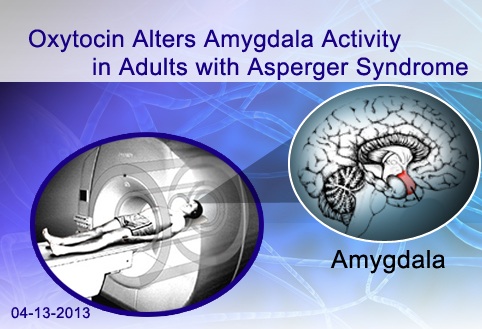
Background: Oxytocin is a hormone that is produced in the brain and released into the bloodstream and central nervous system, where it binds to oxytocin receptors on cells. Its role in helping labor contractions was discovered in the early 1900s, but more recently scientists have examined oxytocin’s ability to mediate social behaviors, presumably by modulating activity in the amygdala—a brain area known to be involved in social and emotional information processing.
What’s New: In a study published online March 6, 2013, in the journal Biological Psychiatry, researchers tested the effect of intranasal oxytocin supplementation on brain activity in response to social stimuli. The researchers administered either oxytocin or placebo, in a double-blinded manner, to 14 adult male volunteers with Asperger syndrome (AS) and 14 neurotypical control participants. They then measured amygdala activity using functional magnetic resonance imaging (fMRI) while the participants viewed images of houses and faces. Oxytocin supplementation significantly increased amygdala activity in response to faces, as compared to houses, in AS participants but not in controls. The placebo did not cause the same effect.
Why it’s Important: Ongoing clinical trials are testing if therapeutic oxytocin can alleviate social cognition difficulties in children and young adults with autism spectrum disorder (ASD). This is the first study to show an oxytocin-induced increase in amygdala activity during facial processing in individuals with Asperger syndrome.
Help me understand :
| Source(s) : |
| Tweet |
Resource List for Cognitive and Motor Issues in Autism
By Shana R. Spindler, PhD on March 7, 2013
News Brief: Children with autism spectrum disorder (ASD) often exhibit cognitive motor impairment and difficulty with sensory processing. While some therapy programs address motor and cognitive issues separately, several organizations are now attempting to treat cognitive and motor difficulties simultaneously in children with ASD, according to a recent commentary in Frontiers in Integrative Neuroscience. These organizations include, but are not limited to, the following:
- Bodyspeaks (https://sites.google.com/site/bodyspeaks/home)
- Helping Autism through Learning and Outreach (HALO; www.halo-soma.org)
- The Institute on Communication and Inclusion (ICI; http:// ici.syr.edu)
- Neurologic Music Therapy Services of Arizona (NMTSA; http://www.nmtsa.org/)
- Therapy Intensive Programs (TIP; www.kriscamp.org)
- Whittier Area Parents’ Association for the Developmentally Handicapped (WAPADH; http://www.wapadh.org/)
Help me understand :
| Source(s) : |
| Tweet |
Cognitive-Behavioral Therapy Eases Anxiety in ASD
By Chelsea E. Toledo, M.A. on February 21, 2013
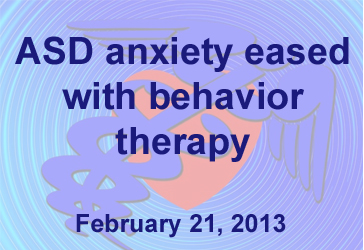
Background: Research demonstrates that about half of children with autism spectrum disorder (ASD) also experience clinically significant anxiety, and that ASD symptoms are often worse when they do. Preliminary studies using cognitive behavior therapy have shown promising results for treating anxiety in ASD individuals
What’s New: In the February 2013 issue of the Journal of the American Academy of Child & Adolescent Psychiatry, researchers demonstrated that an adapted form of cognitive-behavioral therapy (CBT) —an goal-oriented intervention divided into modules for children and parents—was more effective than treatment as usual (TAU) at decreasing symptoms of anxiety in children with ASD in a randomized, controlled trial. The scientists recruited 45 children between the ages of 7 and 11 and divided them into two treatment arms, some receiving CBT and others continuing with the management plan they had taken beforehand. After 16 weeks, 75 percent of participants in the CBT arm responded to treatment, as opposed to 14 percent in the TAU arm.
Why it’s important: Because certain symptoms are common to both ASD and anxiety—namely social avoidance and repetitive responses—CBT could prove an effective treatment for both ASD and anxiety.
Help me understand :
| Source(s) : |
| Tweet |
Deep Brain Stimulation Improves Autism Symptoms
By Chelsea E. Toledo, M.A. on February 7, 2013
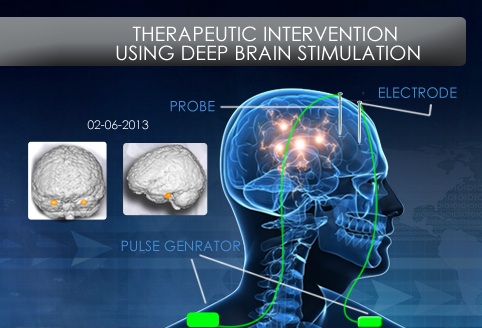
Background: Studies have shown that individuals with Autism Spectrum Disorder (ASD) have up to a 20 percent chance of injuring themselves. In the 1960s and 1970s, interventions were shown to improve epilepsy-related aggression when doctors targeted the amygdala, a brain region associated with emotional learning.
What’s New: In the January 21, 2013, issue of the journal Frontiers in Human Neuroscience, researchers published a study exploring the hypothesis that stimulating the amygdala would alleviate self-injurious behavior (SIB) related to ASD. They surgically implanted electrodes in the amygdala of a 13-year-old boy suffering from Kanner’s autism, also referred to as early infantile autism, and severe SIB. When the electrodes placed in the amygdala’s basolateral section were stimulated, the boy made significant strides in overcoming SIB as well as the emotional, social, and cognitive deficits related to autism.
Why it’s important: This study, the first to demonstrate such results in a patient, suggests that the amygdala—especially its basolateral section—is important for understanding behaviors related to ASD, and could provide a potential target in its treatment.
Help me understand :
| Source(s) : |
| Tweet |
Repurposed Drug Improves ASD Symptoms in Children
By Mark N. Ziats on January 9, 2013
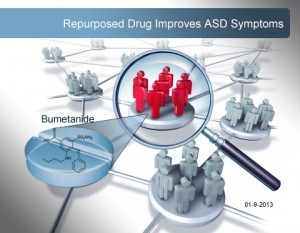
Background: Previous research has indicated that brain signaling using a neurotransmitter known as GABA could be disrupted in children with Autism Spectrum Disorders (ASD). Brain cells use the molecule chloride to modulate the levels of GABA within the brain, and many drugs used for other diseases work by modulating chloride levels. A small pilot study previously suggested drugs which modulate chloride levels in the brain may be beneficial to children with autism.
What’s new: In a study recently published in the journal Translational Psychiatry, researchers tested children with autism or Asperger sundrome using the chloride-altering drug bumetanide, which is known to be safe in children when used for other indications.
The study tested the effect of bumetanide in a double-blinded, placebo-controlled trial of sixty children (ages 3-11) with ASD. The children received either bumetanide or the placebo for 3 months, and were tested for improvement on three separate behavioral rating scales. The results demonstrated that children on bumetanide were significantly more likely to experience improvements in their symptom severity—as determined by improvements in rating scale scores—than autistic children who received the placebo. Importantly, the drug was well-tolerated and caused minimal side effects in all children who received it over the course of the 3 months.
Why it’s important: This study provides evidence that adjusting GABA levels in the brain by modulating chloride levels improves the behavioral symptoms of autism. Because many drugs that act on chloride levels are already known to be safe in children, it is hoped that larger studies can be pursued in order to bring novel treatments targeting this pathways to the clinic.
Help me understand :
| Source(s) : |
| Tweet |
Inclusive Preschools May Improve Autism Outcomes
By Chelsea E. Toledo, M.A. on December 13, 2012

Background: Since 1990, the Individuals with Disabilities Education Act has required that states provide appropriate early intervention and special education to children with disabilities. However, little research has investigated what type of preschool placements are best for children with Autism Spectrum Disorder (ASD).
What’s New: A study published in the journal Autism investigated the differences in outcomes when autistic children were placed in preschools serving only children with ASD, in preschools educating children with a variety of disabilities, or in preschools including children with ASD alongside those with typical development. While the 98 children studied were similar based on demographics and level of initial impairment, the 36 who attended inclusive preschools--where they learned alongside children with typical development--showed greater improvement on cognitive test scores than those attending non-inclusive preschools.
Why it’s important: Among those children attending inclusive preschools, those with the most severe social and behavioral deficits but at least baseline communicative skills experienced the greatest improvement. Further research could help define which preschool placements are most appropriate for children across the autism spectrum.
Help me understand :
| Source(s) : |
| Tweet |
Health Care Providers Create Autism Clinical Database
By Stacy W. Kish on December 6, 2012
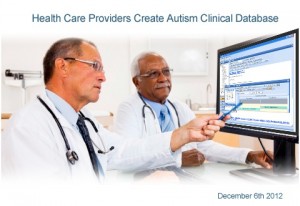
Background: The Centers for Disease Control and Prevention estimates that 1 in 88 children have been diagnosed with some component of autism spectrum disorder (ASD). ASD describes a group of symptoms associated with abnormal brain development. Previously, researchers established the Interactive Autism Network (IAN), an internet-based registry. The network, however, required parents to self-register their child and fill out forms.
What’s new: Kaiser Permanente and Harvard Pilgrim are pooling data retrieved from electronic medical records to create one of the largest autism database to date. Using these resources, the health care providers identified 20,000 people with ASD. Unlike similar networks, this database contains standardized information that will aid researchers as they study the disorder.
Why it’s important: The clinical and scientific community can use this data to understand the prevalence of ASD and current methods used to treat symptoms. In addition, researchers could comb the database to recruit individuals for clinical trials. Finally, organizations hope to develop autism awareness campaigns to help educate underserved communities about the condition. The database will not become available to researchers until privacy issues associated with medical records are resolved.
Help me understand :
| Source(s) : |
| Tweet |
Clinical Trial Examines Novel Therapy for ASD
By Stacy W. Kish on November 27, 2012
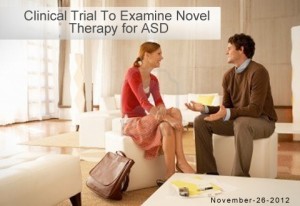
Background: Autism Spectrum Disorder (ASD) describes a group of symptoms associated with abnormal brain development. Three symptoms—repetitive behaviors, awkward social interactions, and difficulty with verbal and nonverbal communication—dominate ASD. Recent research suggests that ASD is associated with a hyperactive immune system. The studies point to the presence of autoantibodies and elevated levels of pro-inflammatory molecules in blood samples from autism patients.
What’s new: Coronado Biosciences, Inc., a biopharmaceutical company in Massachusetts, announced the initiation of a clinical trial to treat adults with ASD. The clinical trial, approved by the U.S. Food and Drug Administration, is focused on the effect of TSO (Trichuris suis ova) on ASD symptoms. TSO is an egg of the porcine whipworm that naturally regulates pro-inflammatory molecules. Patients will receive either TSO or a placebo during the 28-week trial (12-weeks treatment, 4-weeks wash-out period, and 12-weeks treatment). The egg is harmless to the patient who passes it several weeks after dosing.
Why it’s important: This study builds on animal studies that examined the link between inflammation and altered neurodevelopment. It offers a natural therapy to treat the symptoms of ASD in people with autism. The scientists believe TSO will be beneficial in the treatment of repetitive behaviors, irritability, and social cognition in adults with ASD.
Help me understand :
| Source(s) : |
| Tweet |
Brain Activity Normalized after Early Intervention for Autism
By Chelsea E. Toledo, M.A. on November 15, 2012
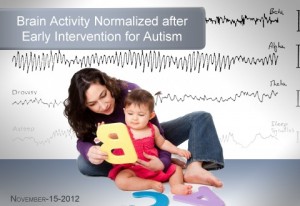
Background: Autism Spectrum Disorder (ASD) can be diagnosed in children as young as 18 months old. Research has shown that earlier interventions for ASD, such as the Early Start Denver Model (ESDM), are associated with better outcomes, including improved IQ, language, and adaptive behaviors like recognizing faces.
What’s New: In a report published in the November 2012 issue of the Journal of the American Academy of Child & Adolescent Psychiatry, researchers detail an additional improvement conferred by ESDM: a better response to stimuli by the brain’s prefrontal cortex. The scientists used electroencephalography (EEG)—a test that measures electrical activity along the scalp—on children between 18 and 30 months of age. Of the 48 participants with ASD, half received ESDM intervention, and the other half received referred therapies through child development programs and individual providers. After two years, the cortical activity of the ESDM group approximated that of children without ASD when they were shown images of faces.
Why it’s important: The findings demonstrate that the brains of children with ASD can process social stimuli in a typical manner when the disorder is addressed early in life using the ESDM. Thus, the severity of ASD can possibly be allayed by way of early intervention.
Help me understand :
| Source(s) : |
| Tweet |
Researchers Modify Therapy Program to Help ASD Teens
By Stacy W. Kish on November 6, 2012
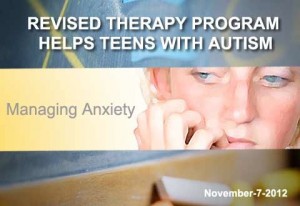
Background: Anxiety is defined by fear and uncertainty. Although most episodes associated with stress are brief, this condition can last for several months. Many teens and children deal with this common mental health issue. Previous research indicates that anxiety affects children with high-functioning autism spectrum disorders (ASDs) at twice the rate as typically developing peers. A group of scientists at the University of Colorado developed a program, called Facing Your Fears (FYF), which uses cognitive behavior therapies to help children (8–14 years of age) with ASD manage anxiety.
What’s new: The Colorado scientists adapted the FYF program to help young adults (13–18 years of age) with ASD manage anxiety during the difficult teen years. The modifications to the study included a focus on social skills, parental involvement, and use of technology to help the participants develop coping strategies to lower anxiety. The participants in the program reported decreased feelings of social anxiety, separation anxiety, and generalized anxiety at the end of the program and at the three-month follow-up. Although the feelings of panic increased slightly at the three-month follow-up visit, the values were still lower than the baseline. Finally, feelings of school anxiety decreased at the three-month follow-up compared to treatment and baseline values.
Why it’s important: This study is one of the few cognitive behavioral therapies that target teens with ASD. The positive results from the participants, although few in number, suggest that the FYF program could be adapted to help this group manage anxiety. Future work may incorporate experimental designs and a larger number of participants to determine the most effective therapy components in the program.
Help me understand :
| Source(s) : |
| Tweet |
Drug Corrects Brain Circuitry in Rett Syndrome Mice
By Ishita Das on October 10, 2012
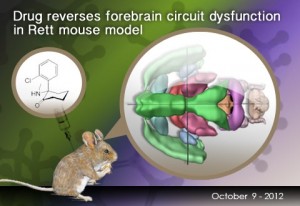
Background: Rett syndrome (RTT) is characterized by severe cardiac and respiratory impairments, together with autistic symptoms. It is believed that the brainstem and spinal cord functions controlling heart rate and breathing are compromised partly by an underactive set of brain structures, known as the limbic system, which are responsible for maintaining an appropriate emotional state. An increased understanding of the neural circuitry that governs behavioral and emotional states is therefore needed.
What’s new: Treating an adult mouse model of RTT with the FDA approved drug ketamine can reverse sensorimotor functions typical of RTT as well as remedy an altered gene expression pattern in the mutant mice, according to a breakthrough study appearing online, 3 October 2012, in the Journal of Neuroscience. Ketamine is a known inhibitor of NMDA receptors, which reduce excitation of neural circuits. Treatment with ketamine likely restores function by balancing neurotransmission.
Why it’s important: RTT occurs with an incidence of 1 in 10,000 females, in which 26% of deaths are sudden and of unknown cause. Cardiac arrhythmias and respiratory failure are considered to be at least partially responsible in some of these fatalities. Ketamine emerges as a strong candidate drug to improve physiological and neural functioning in RTT with important treatment implications for autism, which is rooted in imbalanced neurotransmission.
Help me understand :
| Source(s) : |
| Tweet |
NIH Grant Establishes Atlanta Autism Center of Excellence
By Stacy W. Kish on October 5, 2012
Background: Autism affects an estimated 1 in 88 children nationwide. The disorder is characterized by impaired social and communication skills. Currently, scientists can diagnose autism in children as young as two years of age. Although scientists do not have a firm grasp of what causes autism, they have linked the disorder to variations in brain biology.
What’s new: The National Institutes of Health awarded scientific grants to research institutes in Atlanta, Los Angeles, and Boston. In Atlanta, the funds will be used to develop the Autism Center of Excellence. The Atlanta Center will coordinate local research institutes and hospital resources in this effort.
Why it’s important: This funding will allow scientists to explore new tools to diagnose and treat the disorder. In Atlanta, scientists will apply the federal grant money to four projects focused on social and vocal engagement, early treatment, and brain functioning. The results of this work will develop routine processes to help pediatricians around the country diagnose autism in children at an earlier age.
Help me understand :
| Source(s) : |
| Tweet |
Drug Therapies Show Success for Fragile X Syndrome
By Stacy W. Kish on September 27, 2012

Background: Fragile X syndrome (FXS) is a common genetic cause of intellectual disability and autism. FXS individuals show a constellation of symptoms including intellectual disability, anxiety, epilepsy, attention deficits, hyperactivity and autistic behavior. FXS results from a silenced (turned off) FMR1 gene, which is associated with abnormal neural connections that impair synaptic connectivity.
What’s new: Researchers have conducted rigorous clinical trials using a drug-based therapy that targets a neurobiological pathway known to be altered in FXS. They have examined the effectiveness of STX209, a γ-aminobutyric acid type B (BAGAB) receptor agonist, in a mouse model and human trials. The therapy restored normal neurological connections leading to a reduction in protein synthesis, seizures, and repetitive behaviors in Fmr1-knockout mice in the study; this treatment showed little to no effect on the control mice in the study.
A concurrent study examined the effect of the same therapy on 63 subjects ranging from 6 to 39 years of age. The therapy improved social anxiety, as defined by the Aberrant Behavior Checklist-Social Avoidance scale. The therapy did not show significant success at treating aggression, self-injury, or irritability, as defined by the Aberrant Behavior Checklist (ABC-1).
Why it’s important: The new drug therapies show promise by targeting Fragile X syndrome at the molecular level by balancing neurotransmission. This intervention improved aspects of social behavior in Fragile X individuals with important consequences for autism
Help me understand :
| Source(s) : |
| Tweet |
Rare Form of Autism Reversed in Mice
By Mark N. Ziats on September 11, 2012
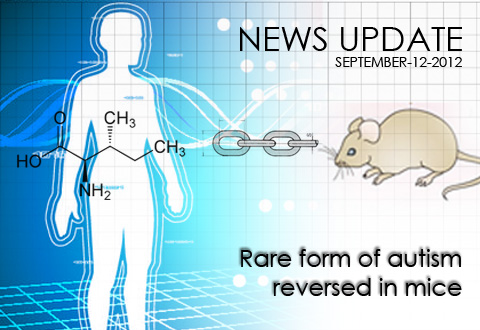
Background:
Many rare forms of autism result from specific variations in a patient’s DNA. The ability to sequence long stretches of DNA has dramatically improved over recent years. Researchers can now use DNA sequencing to read the genetic code of families affected with Autism Spectrum Disorder (ASD) to find mutations that may predispose children to the disease.
What’s New:
In the 6 September 2012 online edition of Science, researchers report a new genetic mutation linked to ASD in a gene that controls the metabolism of branched chain amino acids (BCAAs, a popular supplement among athletes!). Amino acids are important molecules that affect many functions in the body including brain activity. The researchers found lower levels of plasma BCAAs in individuals who carry the mutation in both copies of their chromosomes. Reasoning that amino acids are important for communication within the brain, the authors tested an amino acid supplementation diet in a mouse model that lacked the gene identified in the ASD individuals. The researchers report that neurological symptoms were reversed in the mice put on the diet.
Why it’s important:
While cases of autism caused by this specific mutation are likely to be extremely rare, this research provides some of the first evidence that the symptoms of autism are potentially reversible after their onset. This incredible finding is likely to spur further research into treatments that may improve autism symptoms in humans.
Help me understand :
| Source(s) : |
| Tweet |
FDA-Approved Cord Blood Trial Underway
By Shana R. Spindler, Ph.D. on September 10, 2012
Background:
Researchers have linked Autism Spectrum Disorder (ASD) to variations in hundreds of genes, but some children with autism do not carry any of these known genetic changes. A team of doctors from the Sutter Neuroscience Institute in Sacramento, California observed that cord blood infusions helped improve the condition of a young boy who developed Cerebral Palsy after being trapped in the birth canal for seven hours. The doctors hypothesized that cord blood stem cells, which can communicate with other cells in ways we do not fully understand, may help fix the underlying problem in children with ASD.
What’s New:
The United States Food and Drug Administration (FDA) has approved a clinical trial that will examine the use of cord blood stem cells in the treatment of ASD. Thirty children who have a form of autism with no known genetic cause will receive infusions of their own cord blood in a controlled pilot study. How the cord blood stem cells will target the underlying causes of autism remains unclear.
Why it’s important:
The environmental roots of autism are poorly understood, making treatment tricky. Through innovative clinical trials, we stand to gain important information about therapeutic strategies for autism with diverse etiology.
Help me understand :
| Source(s) : |
| Tweet |
Mouse Model Reveals Therapeutic Strategy
By Shana R. Spindler, Ph.D. on September 4, 2012

Background:
Dravet’s syndrome, a childhood disorder characterized by the onset of seizures within the first year of life, has symptoms common with Autism Spectrum Disorder (ASD) including—but not limited to—hyperactivity, stereotyped behaviors, inhibited social interactions, and marked cognitive deficits. Children with Dravet’s syndrome have a mutation in a string of DNA called the SCN1A gene. While most people have two copies of SCN1A, children with Dravet’s syndrome have only one functioning copy of the gene.
What’s New:
In the 22 August 2012 online edition of the journal Nature, researchers report that genetically engineered mice lacking one copy of SCN1A exhibit hyperactivity, anxiety, increased stereotyped behaviors, deficits in social interactions, and impaired cognitive function. According to the report, a specific type of neuron, called a GABAergic interneuron, requires two copies of SCN1A to hold back the transmission of electrical stimulation. When the researchers give the mice clonazepam, a type of drug known to help neurons block the spread of electric activity, the mice no longer exhibit impaired social behaviors and cognitive deficits.
Why it’s important:
Experiments with the mouse model of Dravet’s syndrome show that disruption of neuron inhibition may be one of the underlying causes of autism. Drugs that can restore the balance between inhibition and excitation of neurons are a potential therapeutic strategy for treating symptoms in some ASD-related syndromes.
Help me understand :
| Source(s) : |
| Tweet |
Oxytocin May Improve Social Interaction in Autism
By Catherine Croft Swanwick, Ph.D. on July 26, 2012
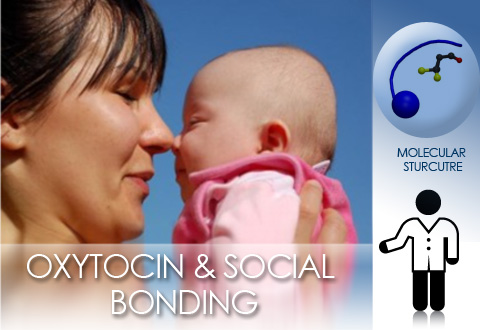
Overview: New evidence suggests that administration of the neuropeptide oxytocin may improve social interaction among people with Autism Spectrum Disorders (ASD).
Background: Oxytocin is well known as a neuropeptide which shapes social behavior. Its expression is regulated by parent-infant bonding and variants of its gene, OXTR, have been linked to ASD.
What’s New: Two recent studies show that an oxytocin nose spray affects social interaction. One research team showed that ASD individuals who took the oxytocin nose spray improved their ability to discriminate non-verbal social cues and increased their attention to other people’s eyes. Another research group demonstrated that fathers who took the oxytocin nose spray bonded more with their infant during a play session, leading to enhanced oxytocin expression and social interaction in the infant, as well.
Why it’s Important: This evidence provides support for the therapeutic potential of oxytocin for ASD. Moreover, oxytocin delivery to the parent instead of the infant may still enhance social behaviors in infants at risk for ASD. However, it should be noted that effects of the oxytocin nose spray are short-lived and may vary among individuals depending on ASD symptoms and severity.
Help me understand :
| Source(s) : |
| Tweet |
Effectiveness of Sensory Integration Therapy Unknown
By Catherine Croft Swanwick, Ph.D. on May 28, 2012
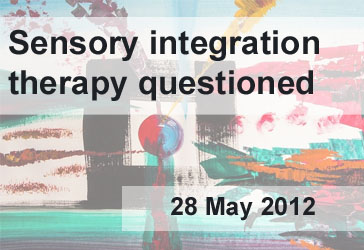
Background: Sensory-based therapies are increasingly used for neurodevelopmental disorders such as autism, but the American Academy of Pediatrics now cautions parents about the lack of research regarding their effectiveness. Many autistic children are overly sensitive to sensory input (i.e., sound, light, touch). Sensory–based therapies aim to help them cope with these sensitivities in daily life.
What’s New: The lack of data about sensory integration therapy spurred the council of pediatricians to make three main recommendations, summarized here:
- At this time, pediatricians should not use sensory processing disorder as a diagnosis. Instead, when sensory symptoms are present, other neurodevelopmental disorders should be considered.
- Pediatricians should recognize and communicate with families about the limited data on the use of sensory-based therapies for childhood developmental and behavioral problems.
- Pediatricians can teach families to evaluate the effectiveness of sensory-based therapies, such as with trial periods and monitoring techniques.
Why It’s Important: Although sensory-based therapy may be acceptable as one component of a comprehensive treatment plan, parents and pediatricians should closely monitor its effects.
Help me understand :
| Source(s) : |
| Tweet |
French Film Criticizes Psychoanalysis for Autism
By Shana R. Spindler, Ph.D. on January 26, 2012
Pop News Brief: A French documentary about the use of psychoanalysis and the “talking cure” in the treatment of autism is receiving quite a bit of attention, according to a recent New York Times report. Psychoanalysis is a psychological theory that associates certain mental disturbances with events from childhood. According to the documentary, approximately 80% of mental health professionals in France are trained in psychoanalysis. The documentary suggests that France’s widespread use of psychoanalysis, as opposed to cognitive-behavioral therapies used in the United States, is putting French children with autism at a disadvantage. Three of the psychoanalysts interviewed in the film believe they were misled and have filed a lawsuit asking for monetary damage compensation and removal of their interviews from the documentary, reports the New York Times. A court decision is scheduled for today.
Help me understand :
| Source(s) : |
| Tweet |
Strategy to Treat Angelman Syndrome Tested
By Shana R. Spindler, Ph.D. on January 4, 2012
Overview: In a recent issue of Nature, researchers report a therapeutic strategy to treat Angelman syndrome, a developmental disorder related to autism.
Background: Angelman syndrome is caused by a defective version of the UBE3A protein, which helps tag other proteins for elimination from the cell. Individuals get one paternal and one maternal copy of the UBE3A gene, but through a process known as imprinting, only the maternal copy is expressed. Normally, even if the maternal copy of the gene is nonfunctional, the paternal UBE3A remains silent.
What's new: Researchers recently identified a drug, called Topotecan, that allows cells to express the paternal copy of UBE3A by inhibiting part of the cellular machinery that winds and unwinds DNA. After injecting very small amounts of Topotecan into the brains of Angelman syndrome mouse models, the researchers found that neurons from various areas of the brain began making the UBE3A protein from the paternal copy of the gene.
Why it's important: Topotecan is a promising therapeutic strategy for treating Angelman syndrome, suggest the authors. However, the researchers also stress the importance of additional studies to investigate the off-target affects of the drug.
Help me understand :
| Source(s) : |
| Tweet |
Prozac May Reduce Repetitive Behaviors in ASD
By Shana R. Spindler, Ph.D. on December 21, 2011
Pop News Brief: Time magazine recently reviewed new research that suggests Prozac can significantly decrease repetitive behaviors in adults with Autism Spectrum Disorder (ASD). Prozac works by increasing the amount of a neurotransmitter known as serotonin in the brain. Researchers from the Albert Einstein College of Medicine and the Mount Sinai School of Medicine administered either Prozac or placebo for 12 weeks to adults with an ASD. About 35% of the participants who took Prozac saw an overall improvement in repetitive and compulsive behaviors, compared to 0% who took placebo. Additionally, 50% of the adults on Prozac saw an improvement specifically in obsessive-compulsive symptoms, while only 8% of the participants on placebo improved.
Help me understand :
| Source(s) : |
| Tweet |
Oxytocin May Help Those with Autism
By Shana R. Spindler, Ph.D. on November 11, 2011
Pop News Brief: A recent article in the Wall Street Journal (WSJ) highlighted studies investigating the use of the hormone oxytocin as a treatment for symptoms experienced by people with neurodevelopmental disorders, such as autism. The article, in part, explored the finding that puffs of oxytocin in the noses of patients with high-functioning autism can reduce repetitive behaviors, decrease irritability, and increase their overall ability to function.
Help me understand :
|
|
Source(s) : |
| Tweet |
Bandit the Robot Helps Children with Autism
By Shana R. Spindler, Ph.D. on November 11, 2011
Pop News Brief: In an ironic twist, researchers at the Robotics Research Lab of the University of Southern California are testing the use of a child-sized robot to help children with autism learn how to interact with people. According to the researchers, a robot may be less intimidating than a person to a child with autism. The pilot studies are promising, showing an increase in social behaviors that are normally lacking in children with autism.
Help me understand :
|
|
Source(s) : |
| Tweet |
California Commands Coverage
By Shana R. Spindler, Ph.D. on November 10, 2011
Pop News Brief: On October 9, 2011, California Governor Jerry Brown signed into law the requirement for health insurance providers to offer coverage to children with autism and other developmental disorders. The signed bill makes California the 28th state to mandate health insurance coverage for those with autism.
Help me understand :
| Source(s) : |
| Tweet |


